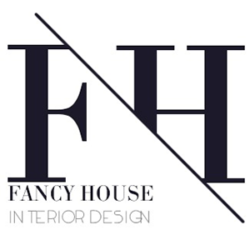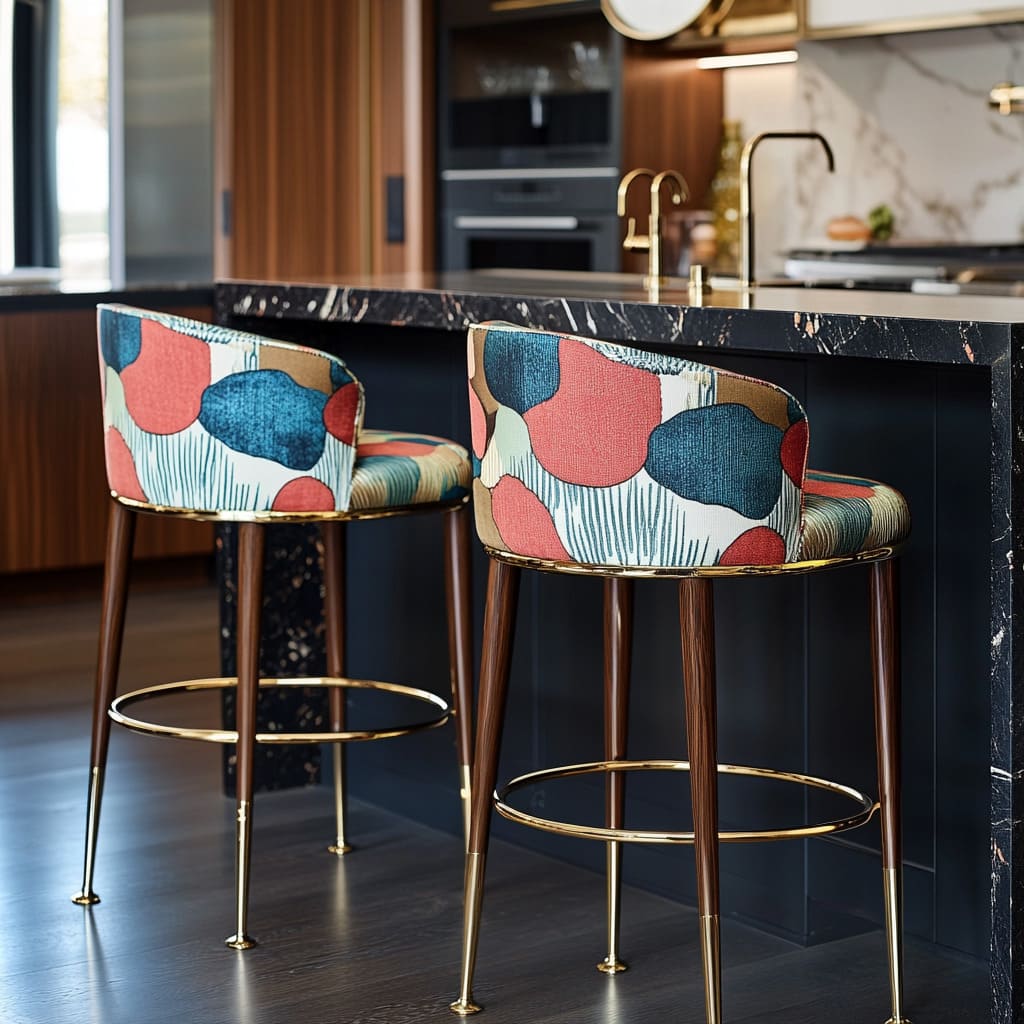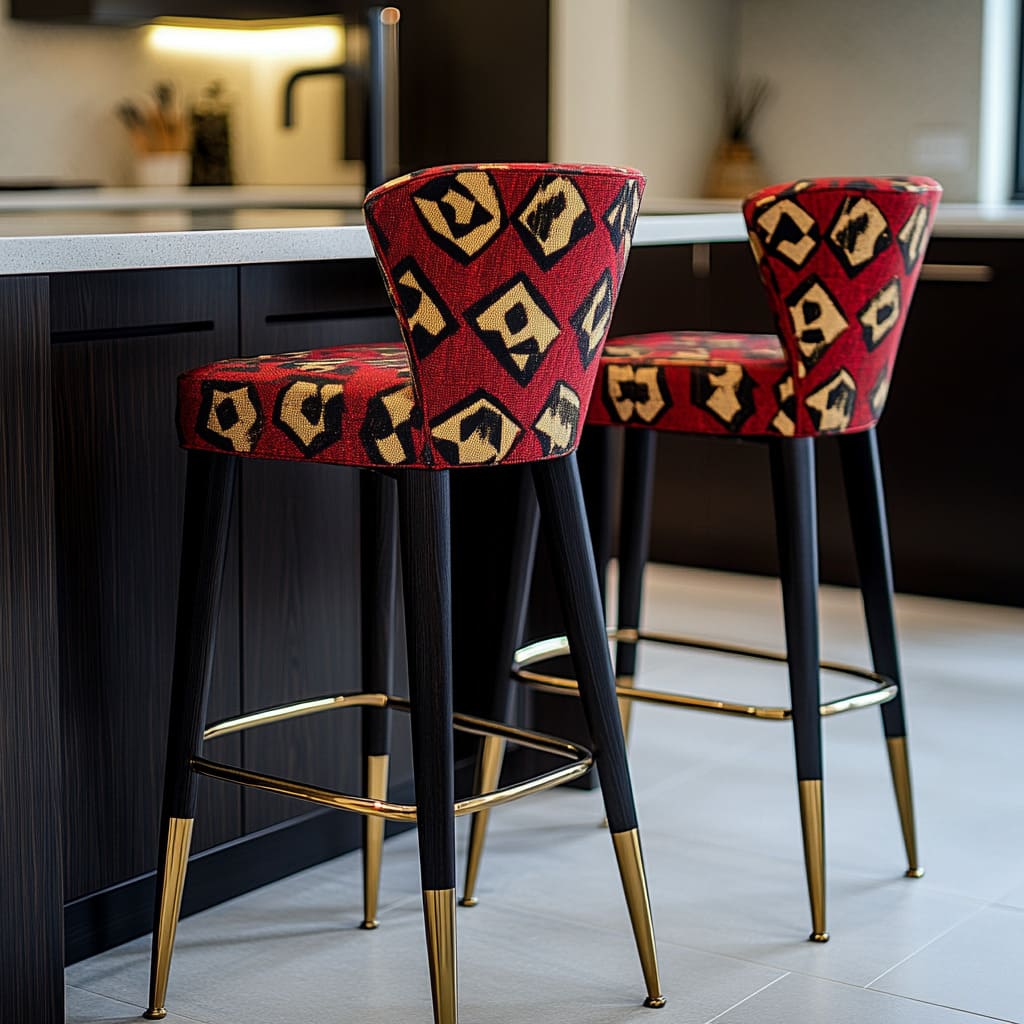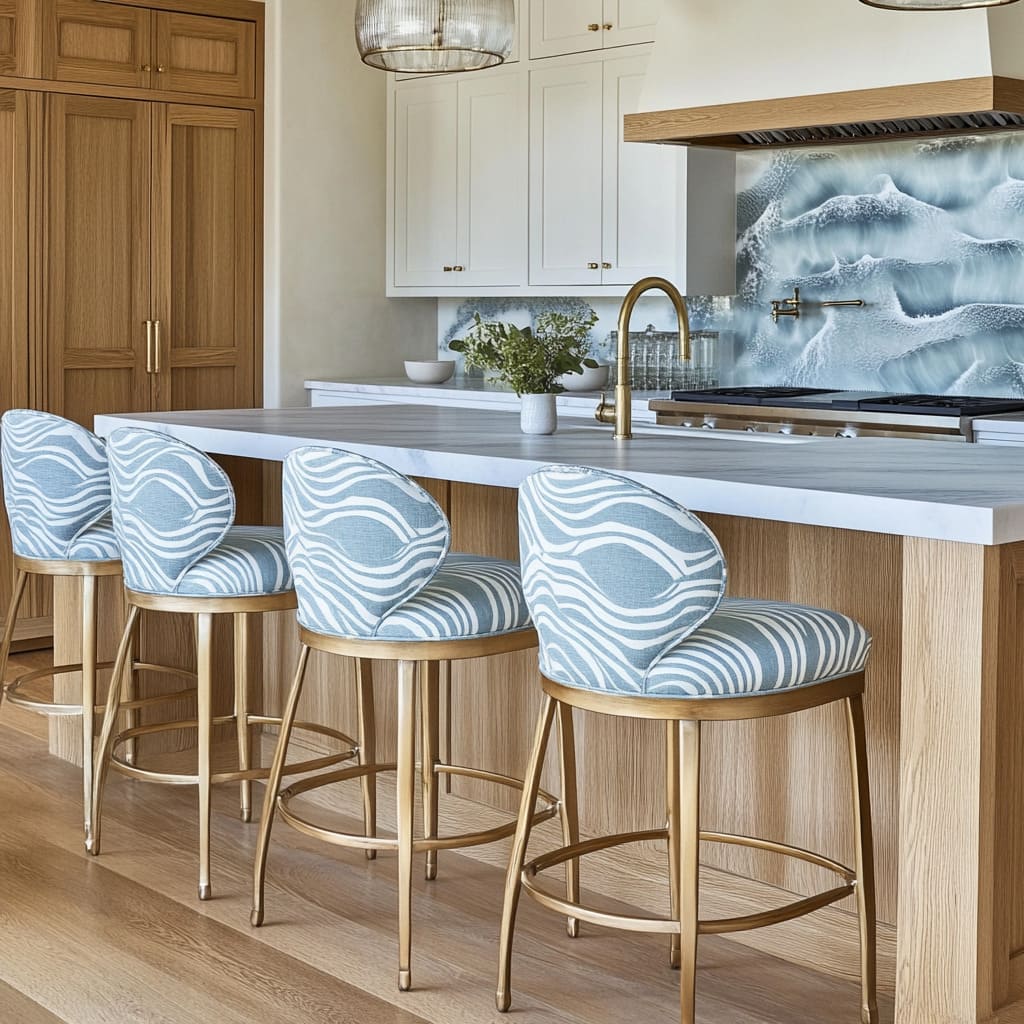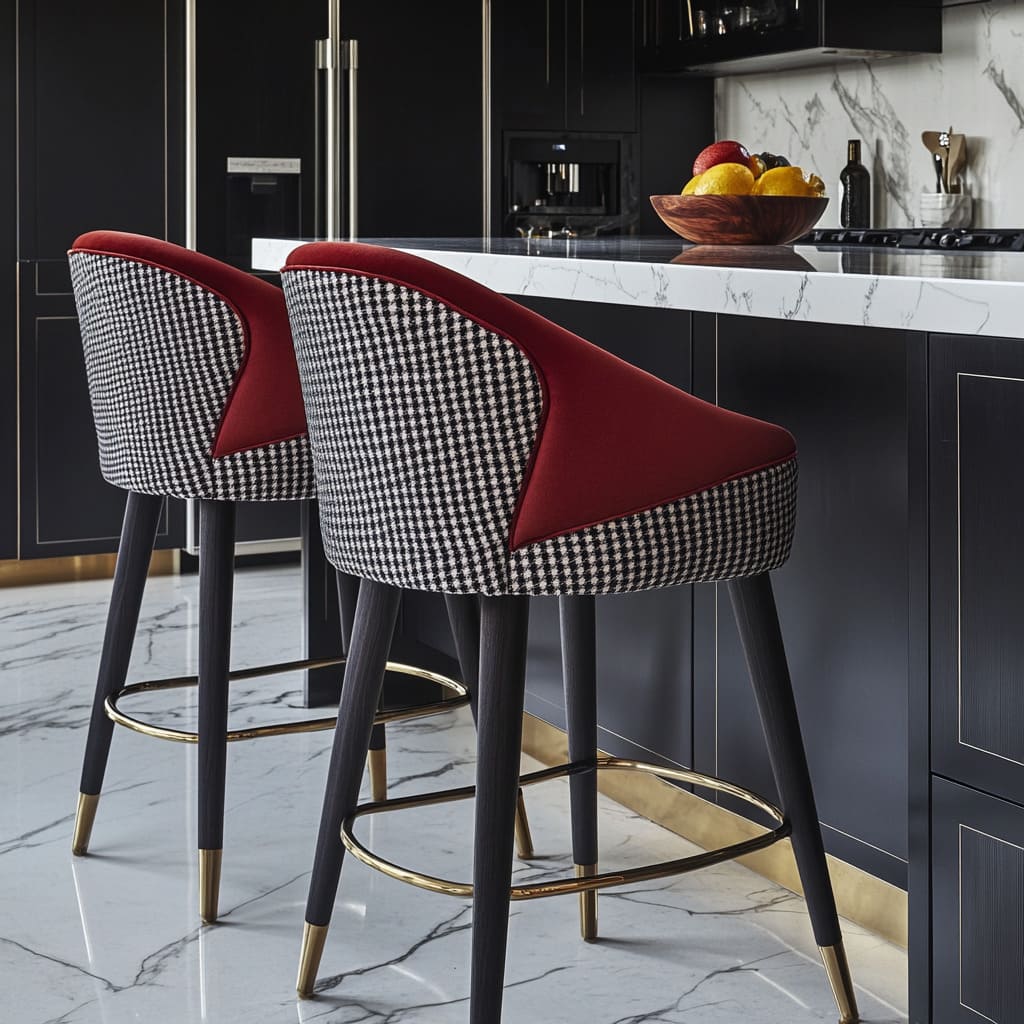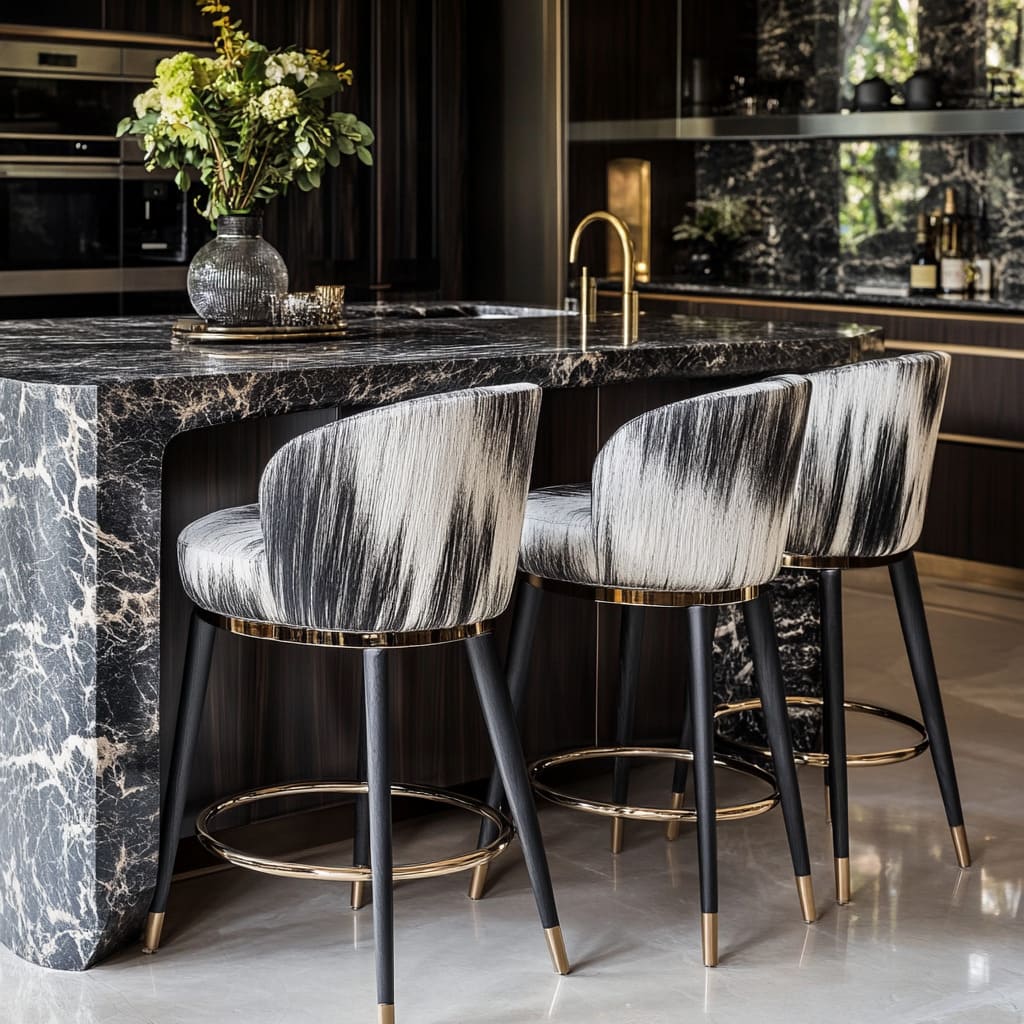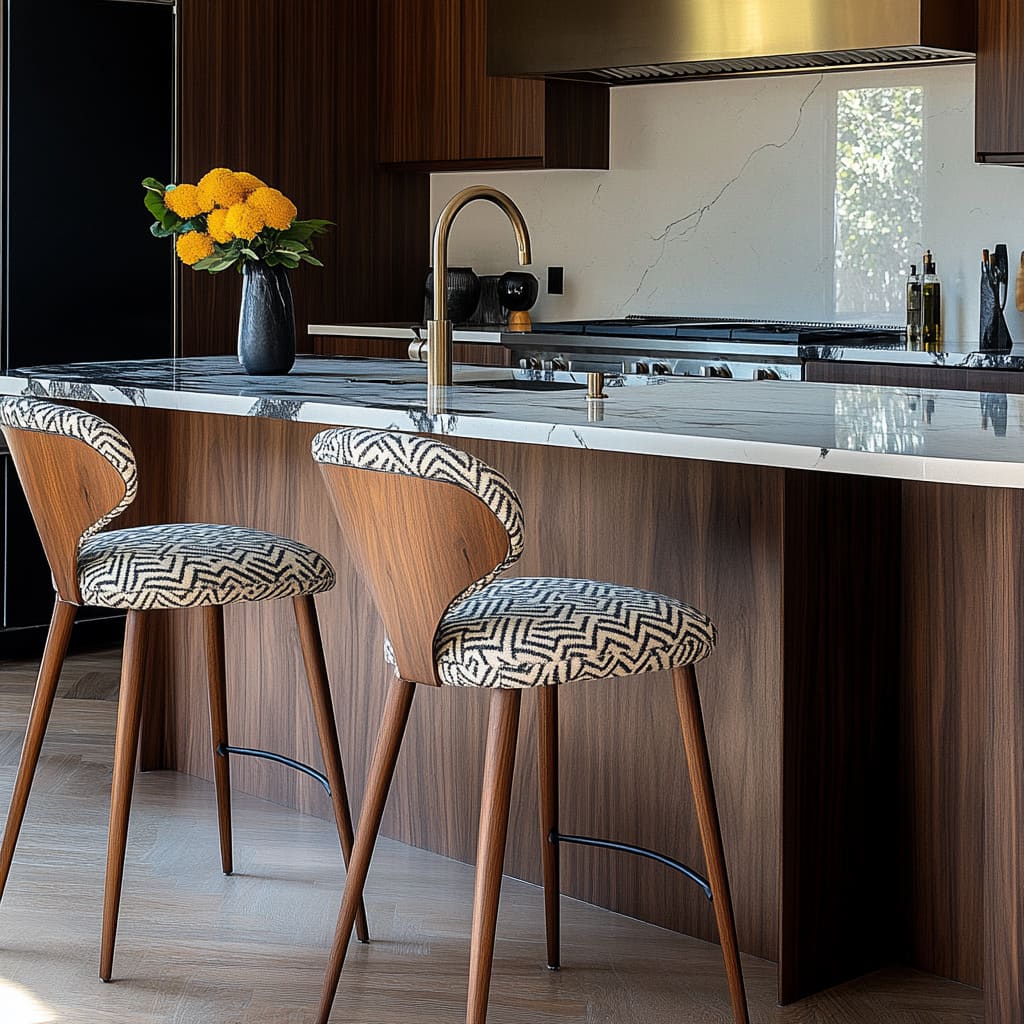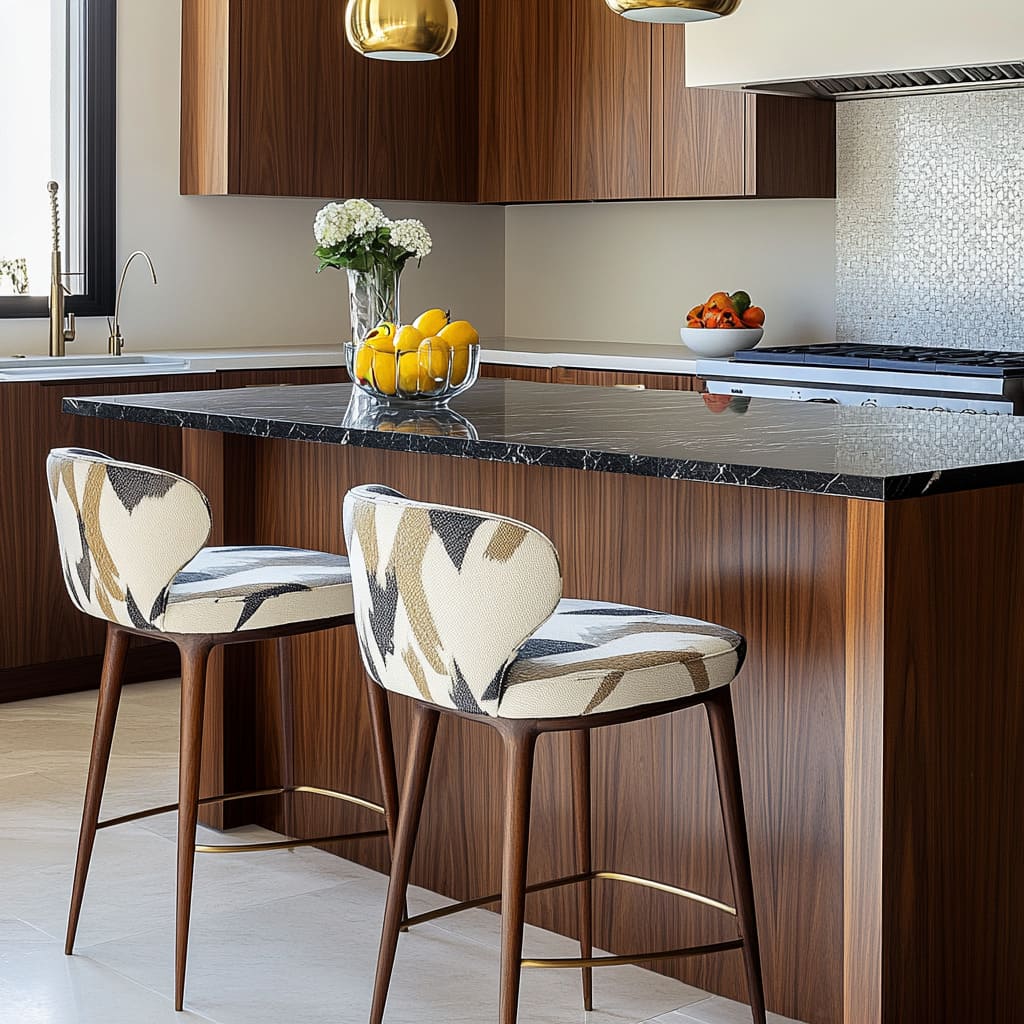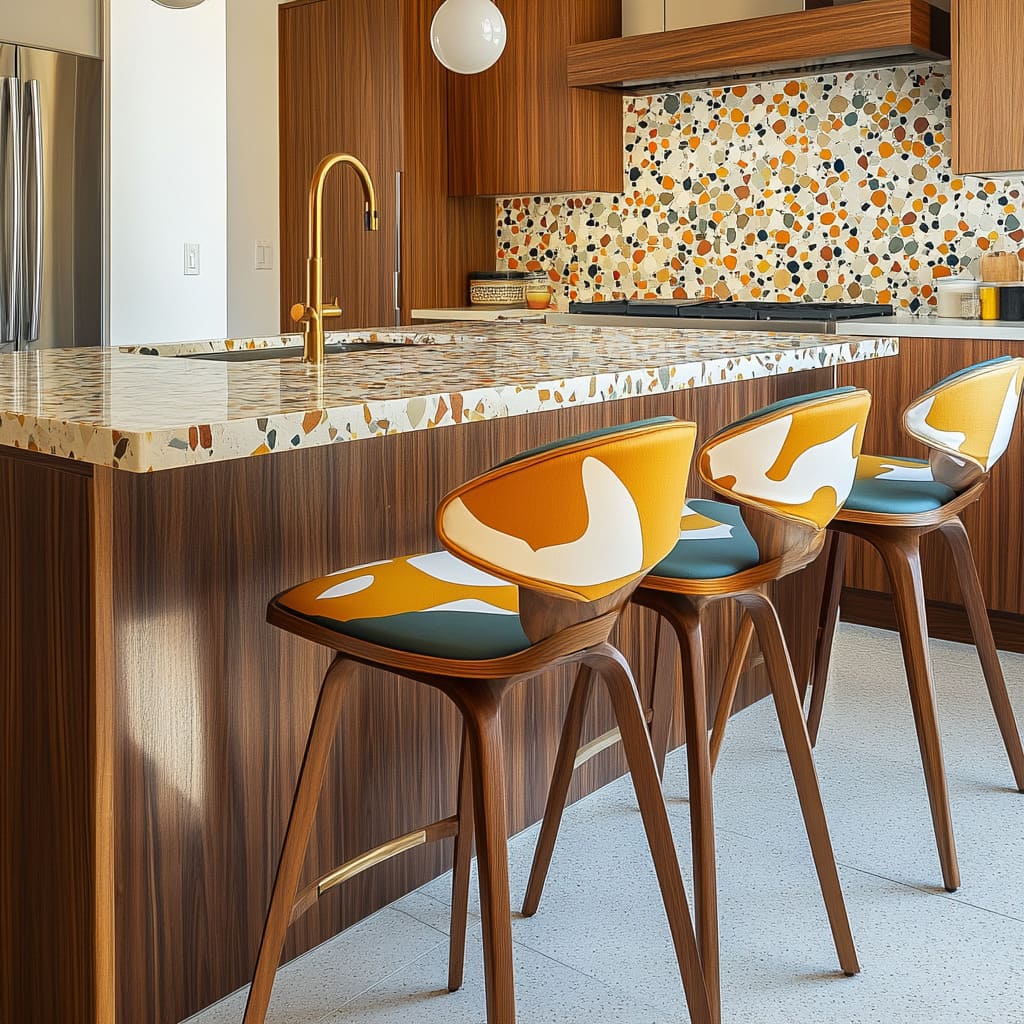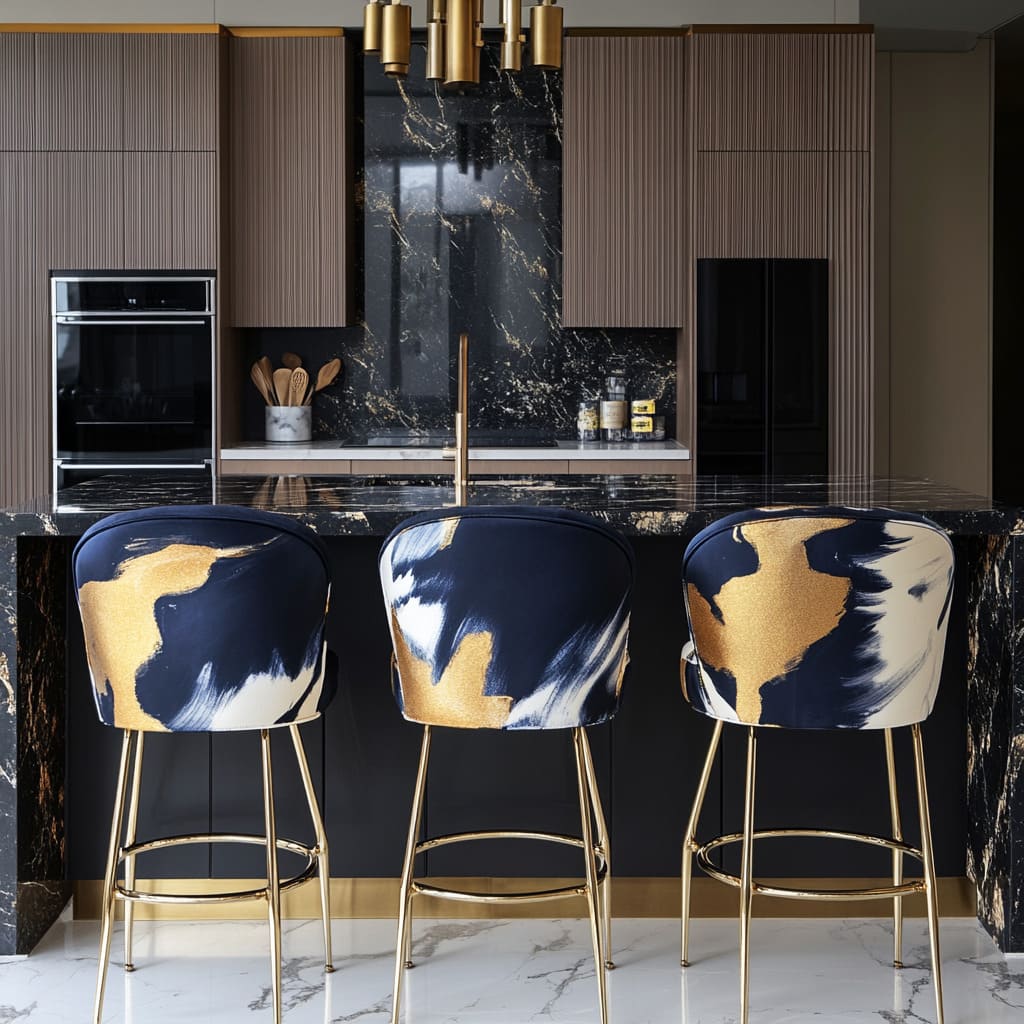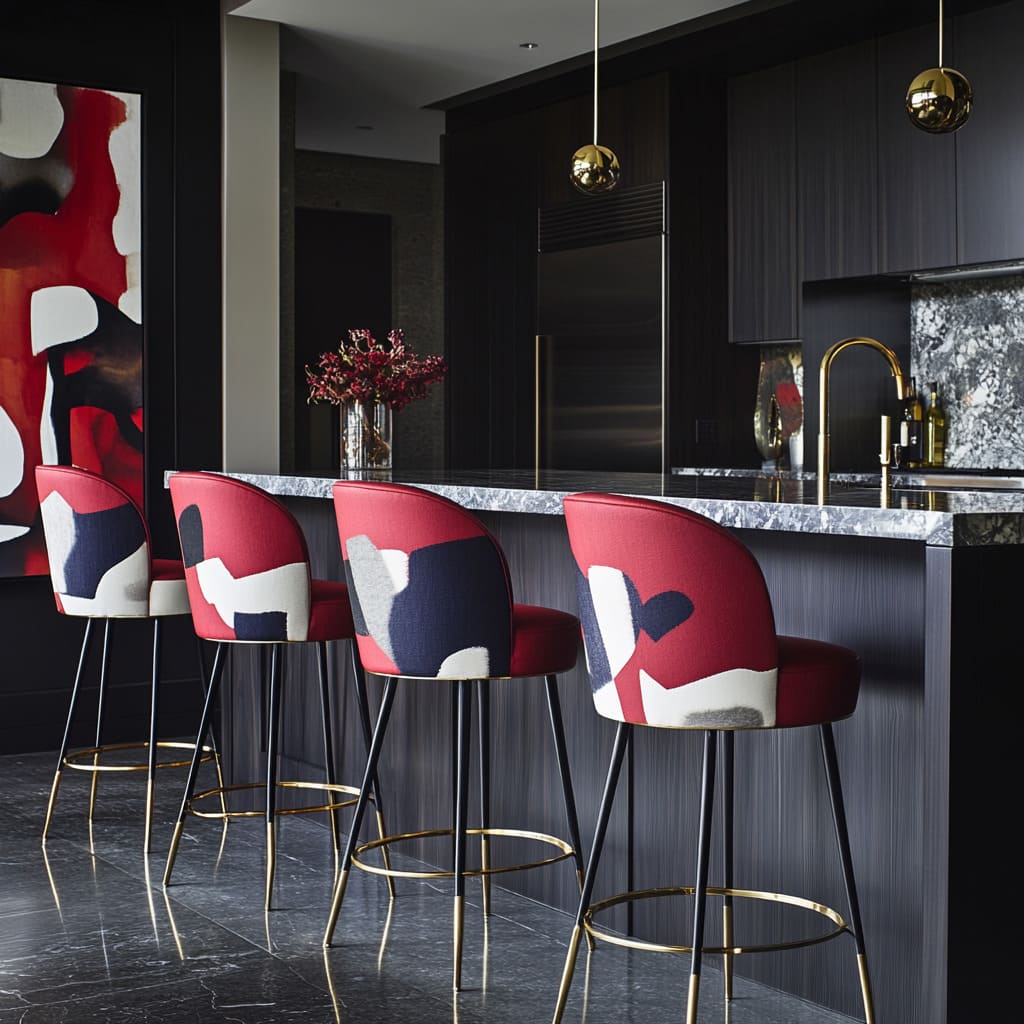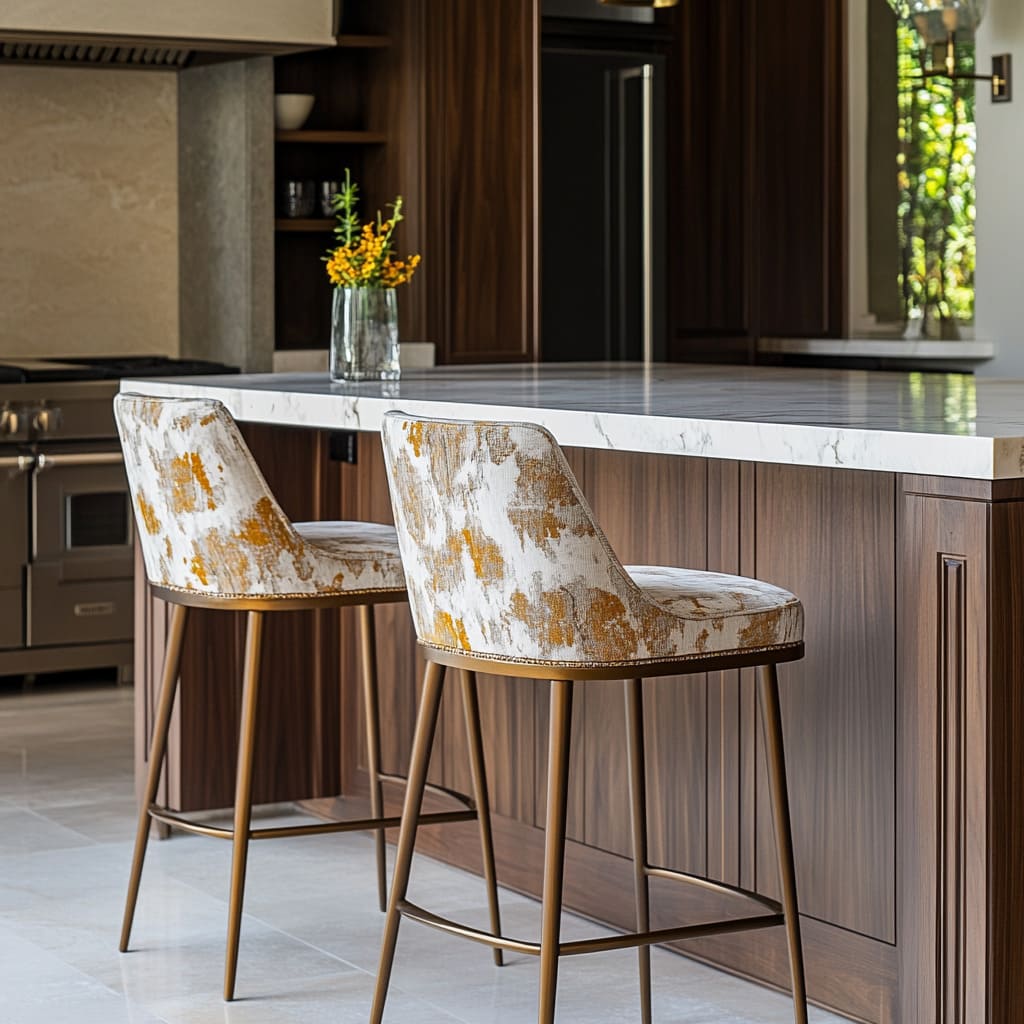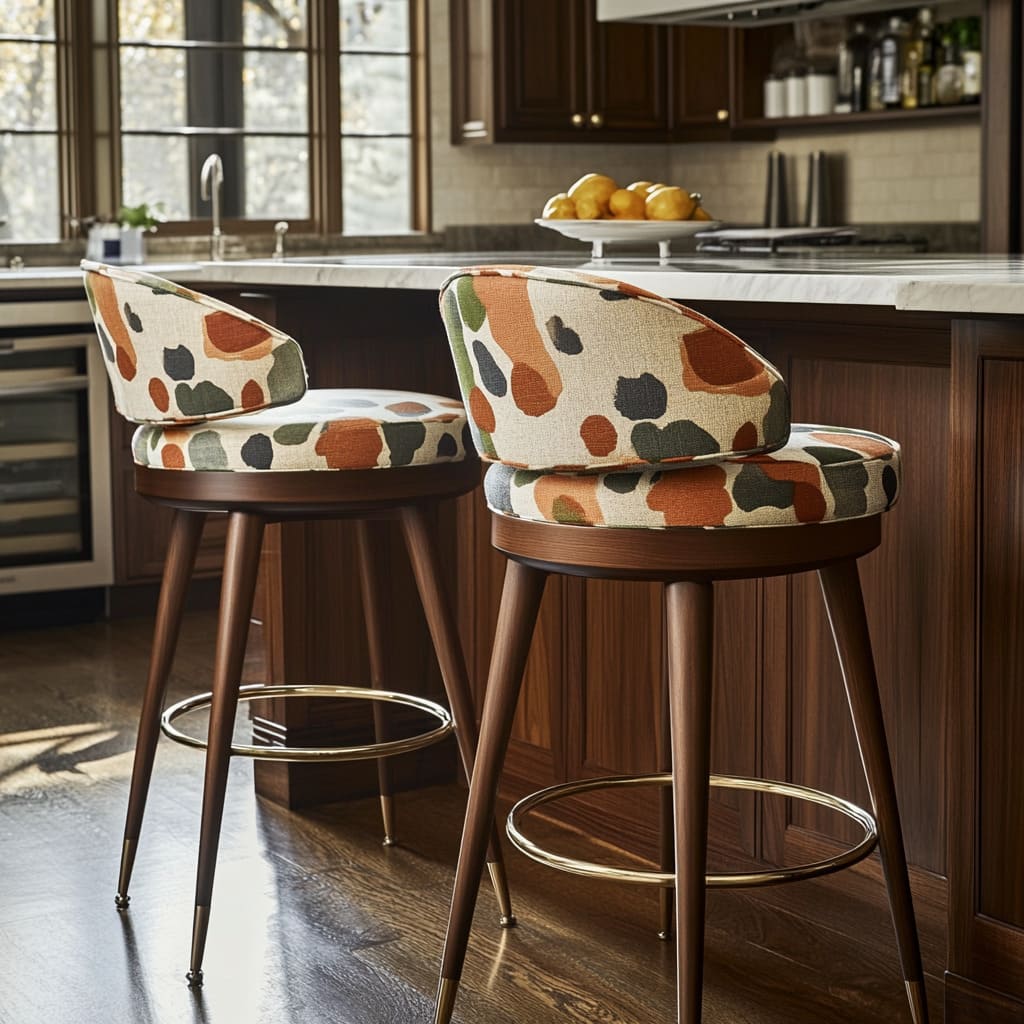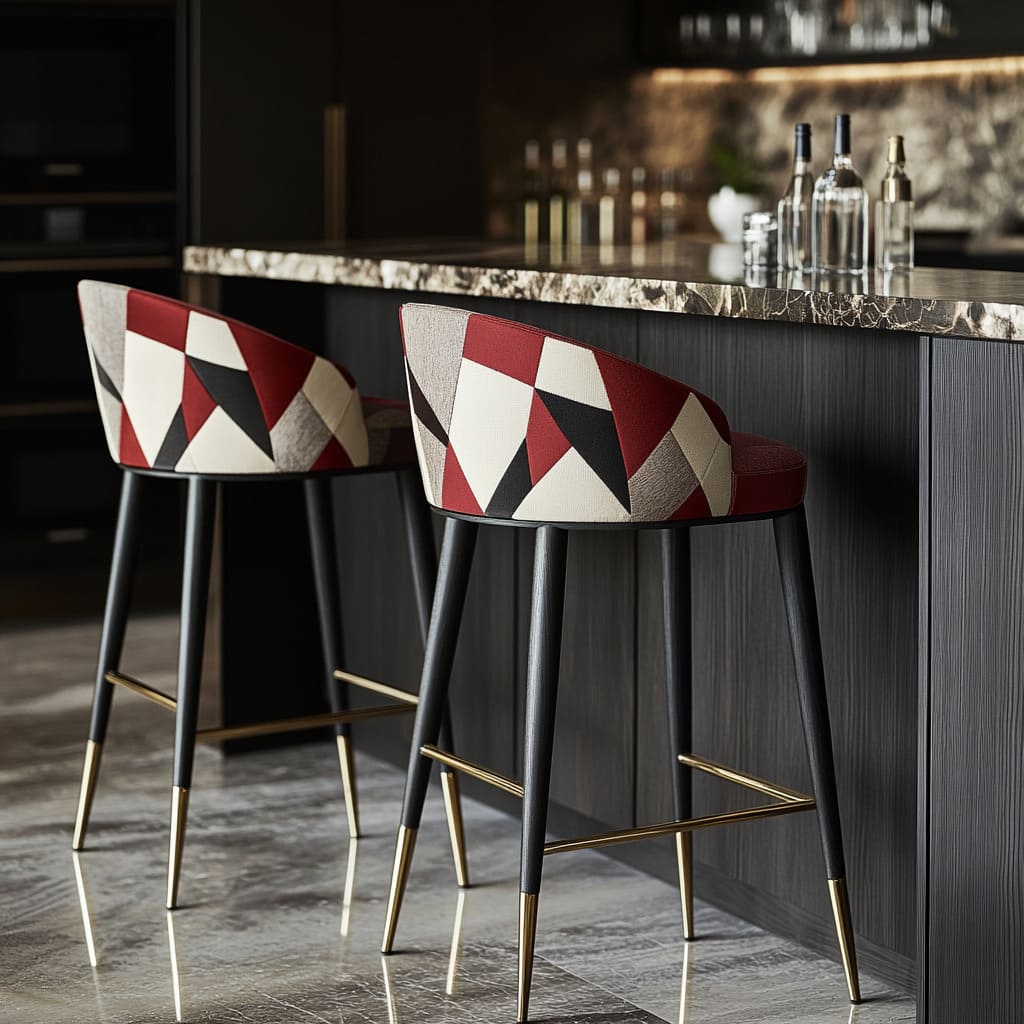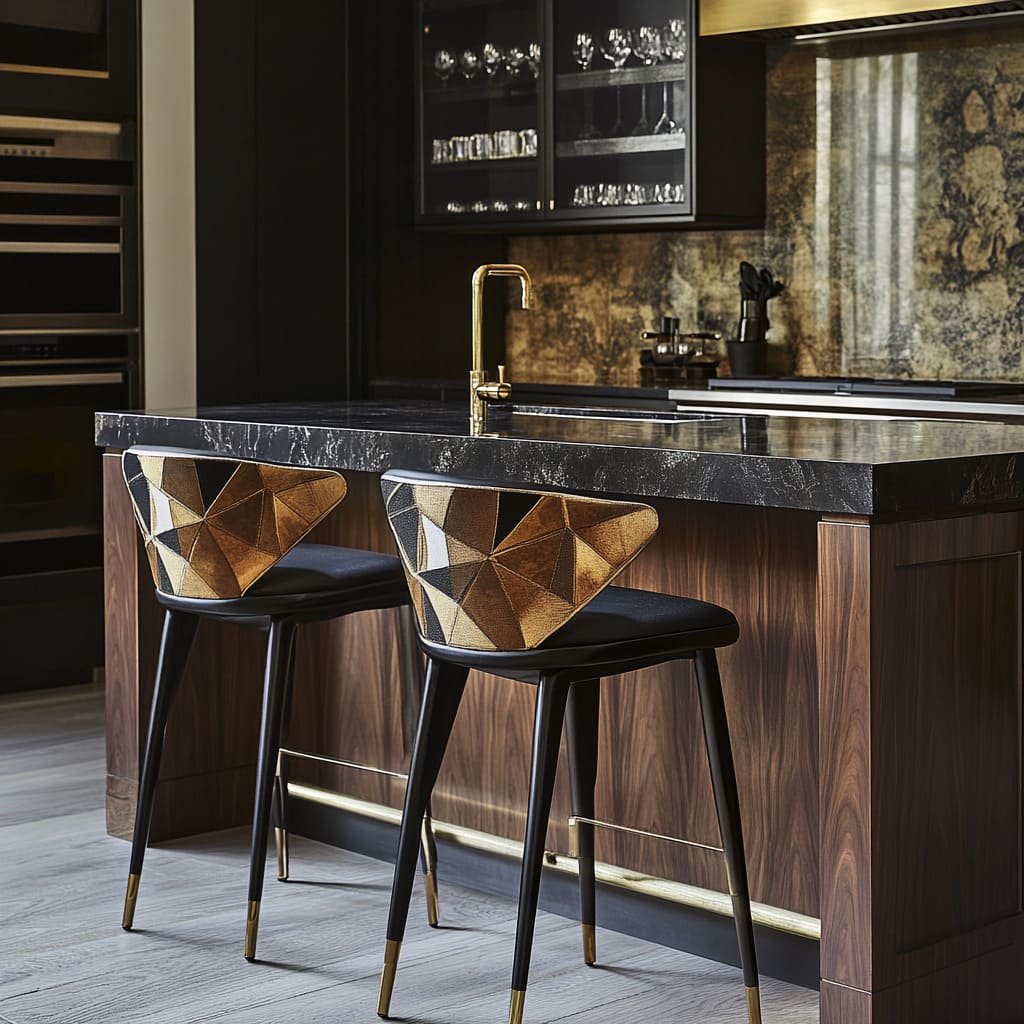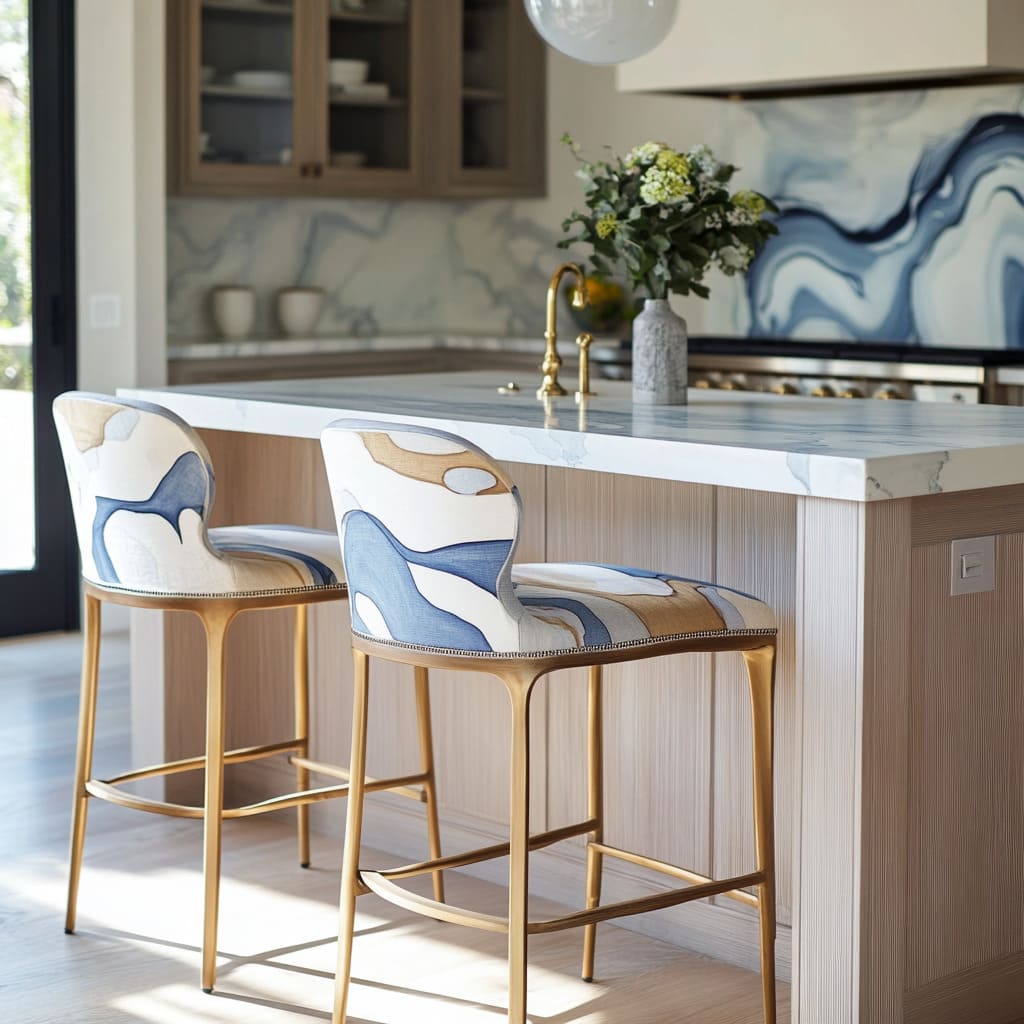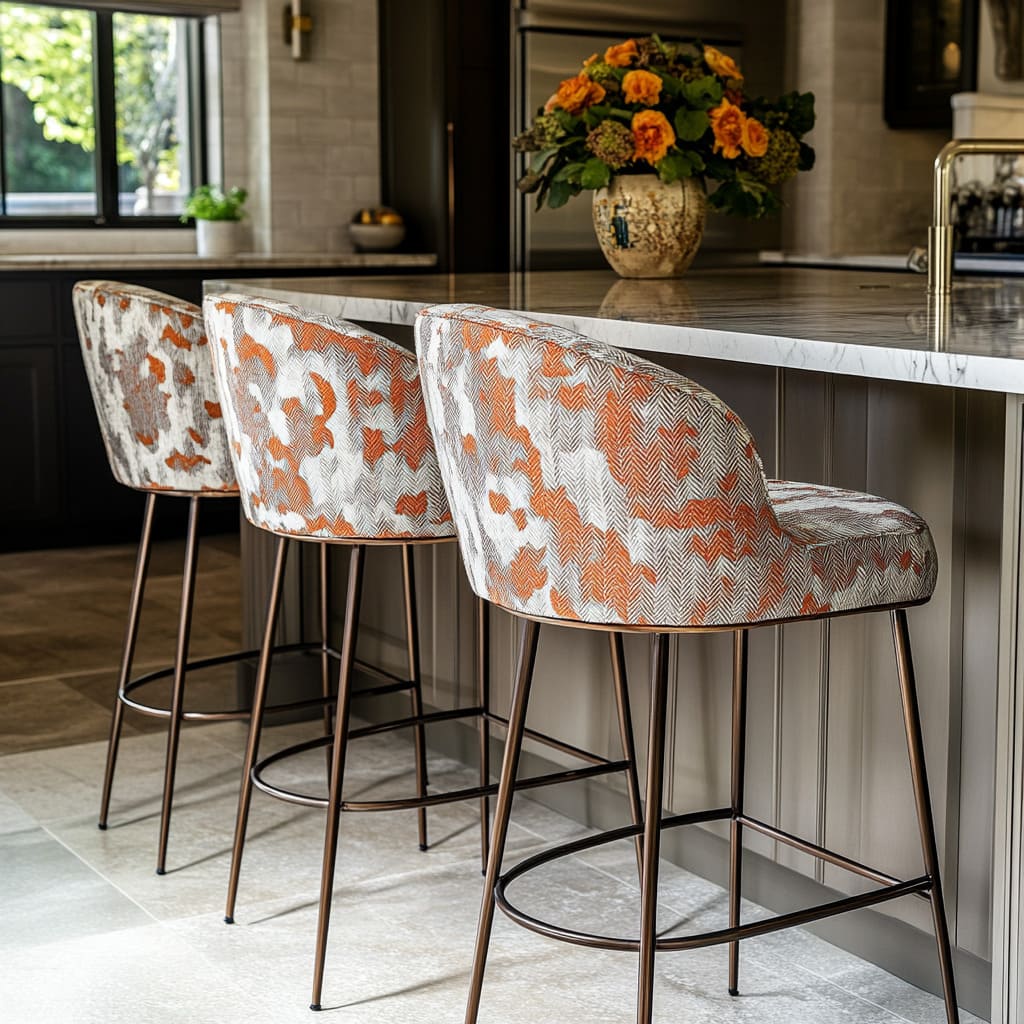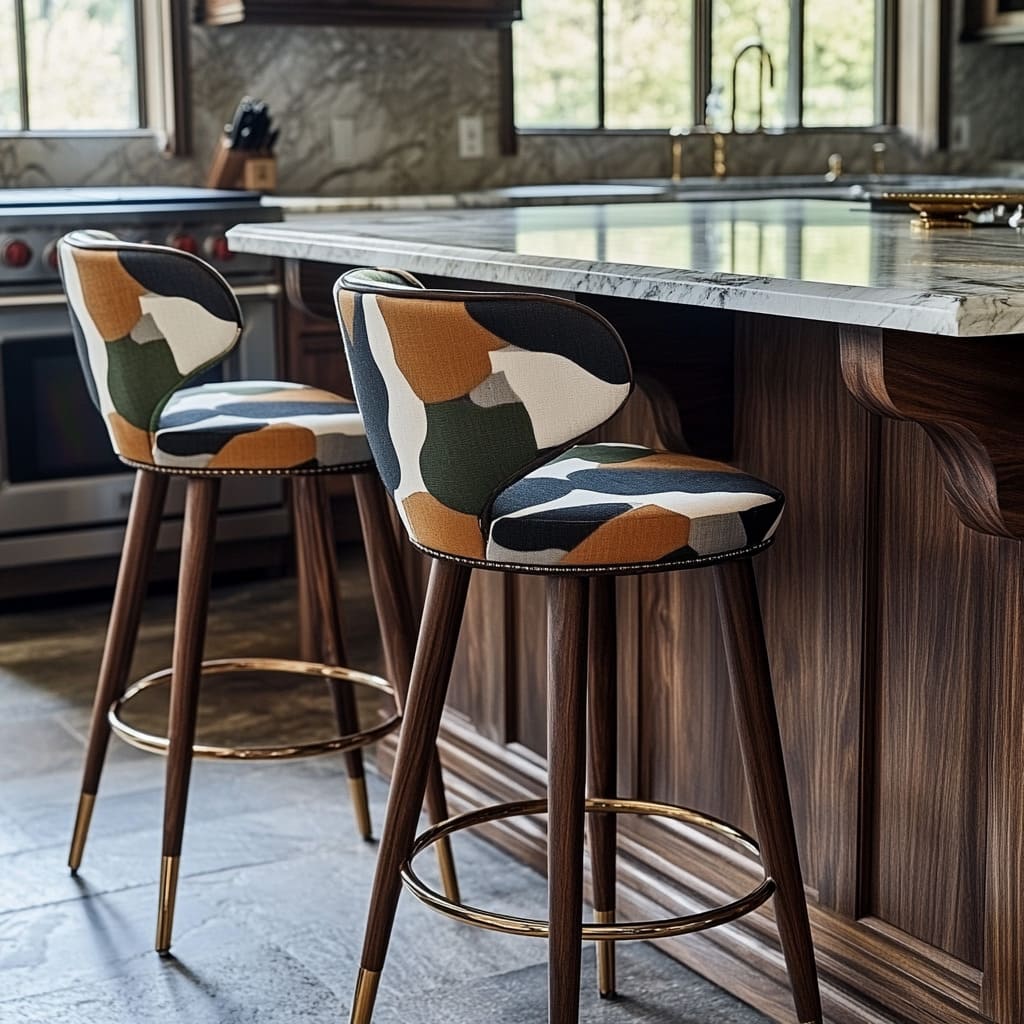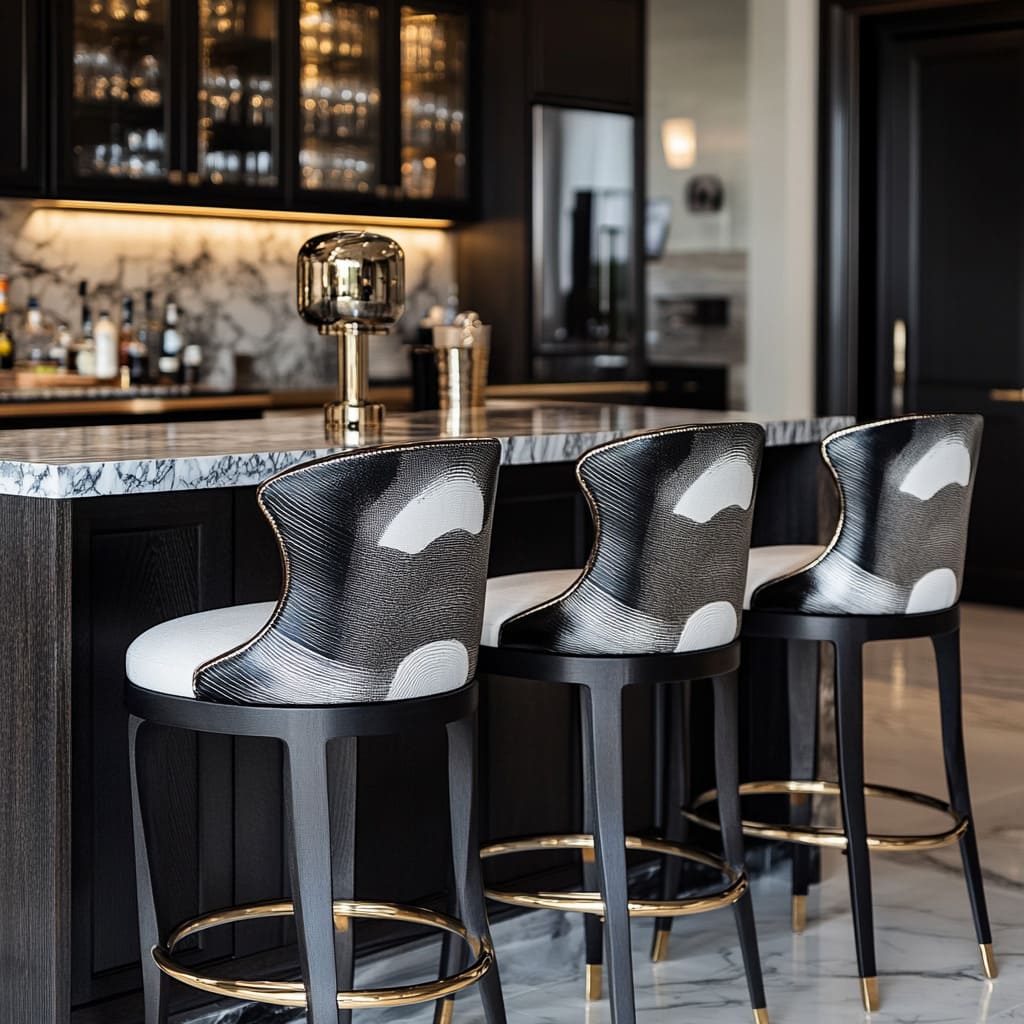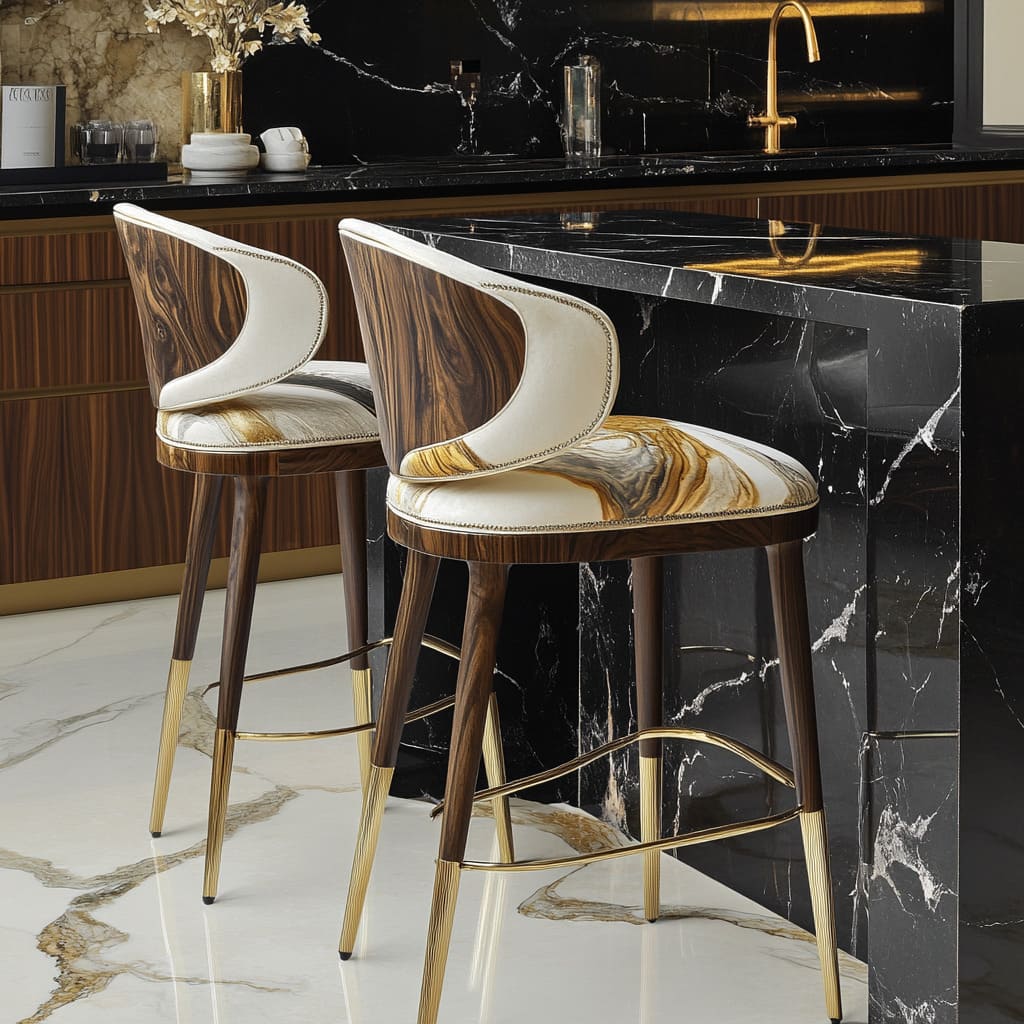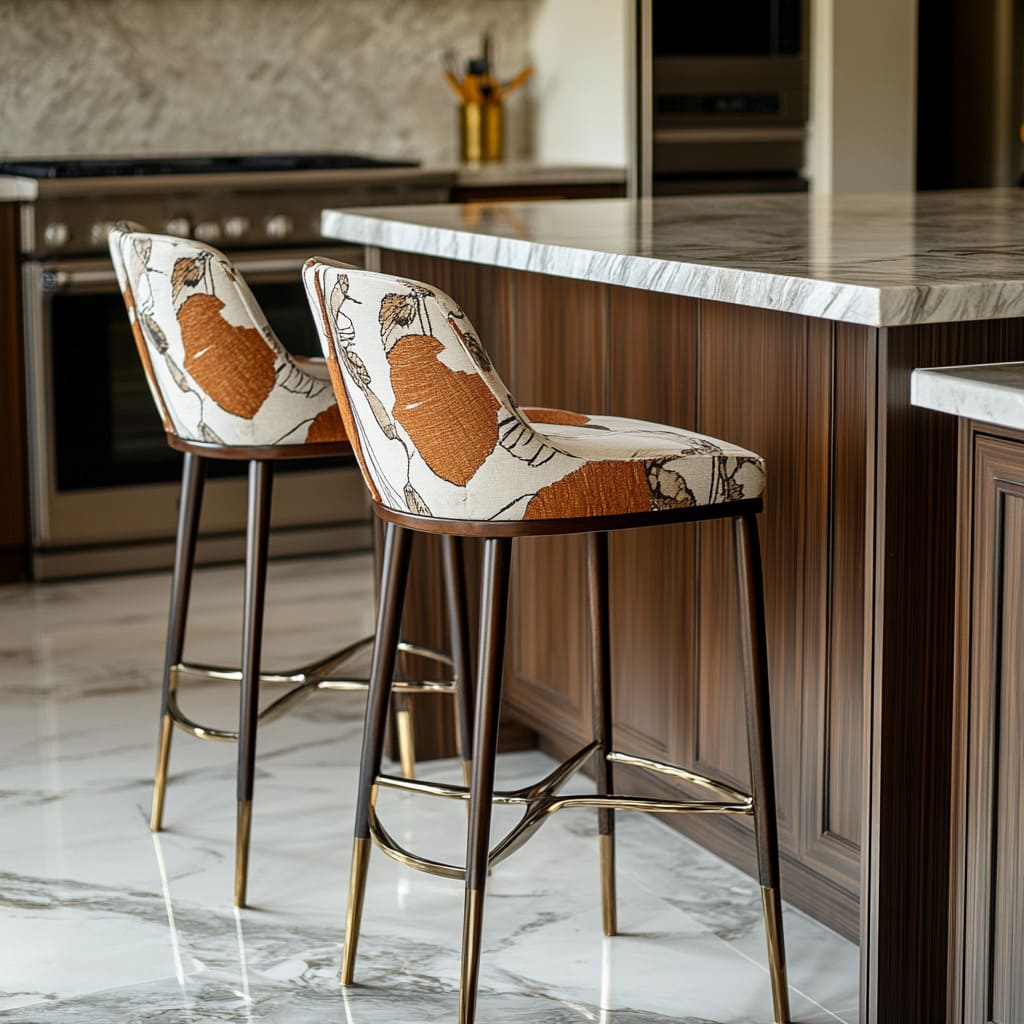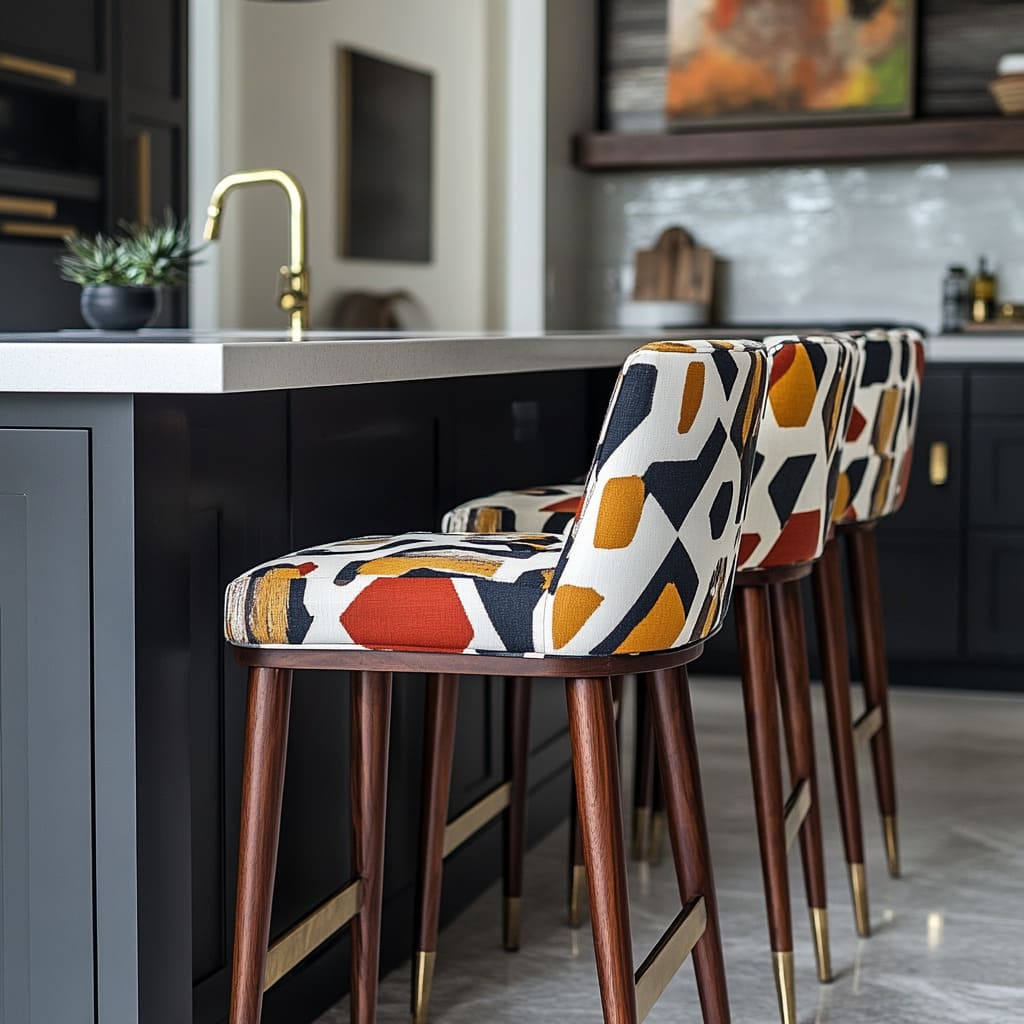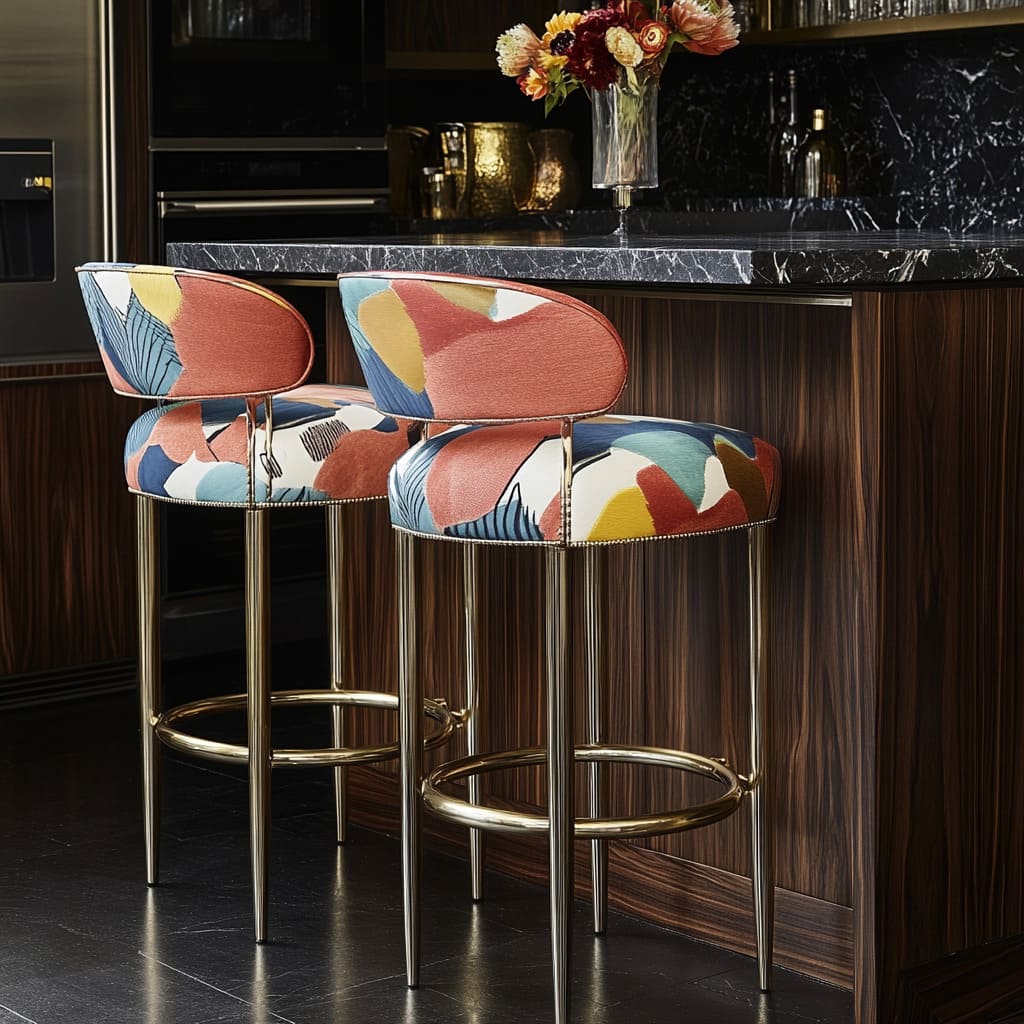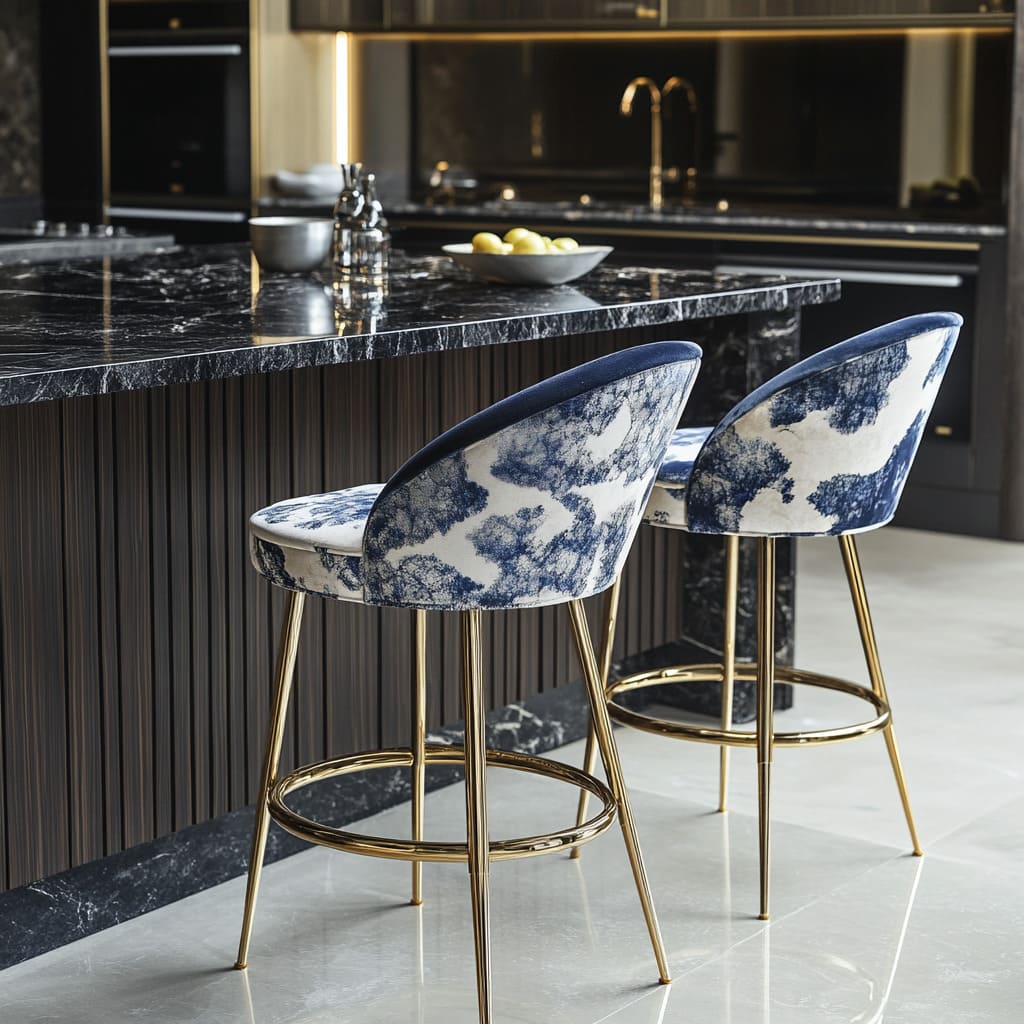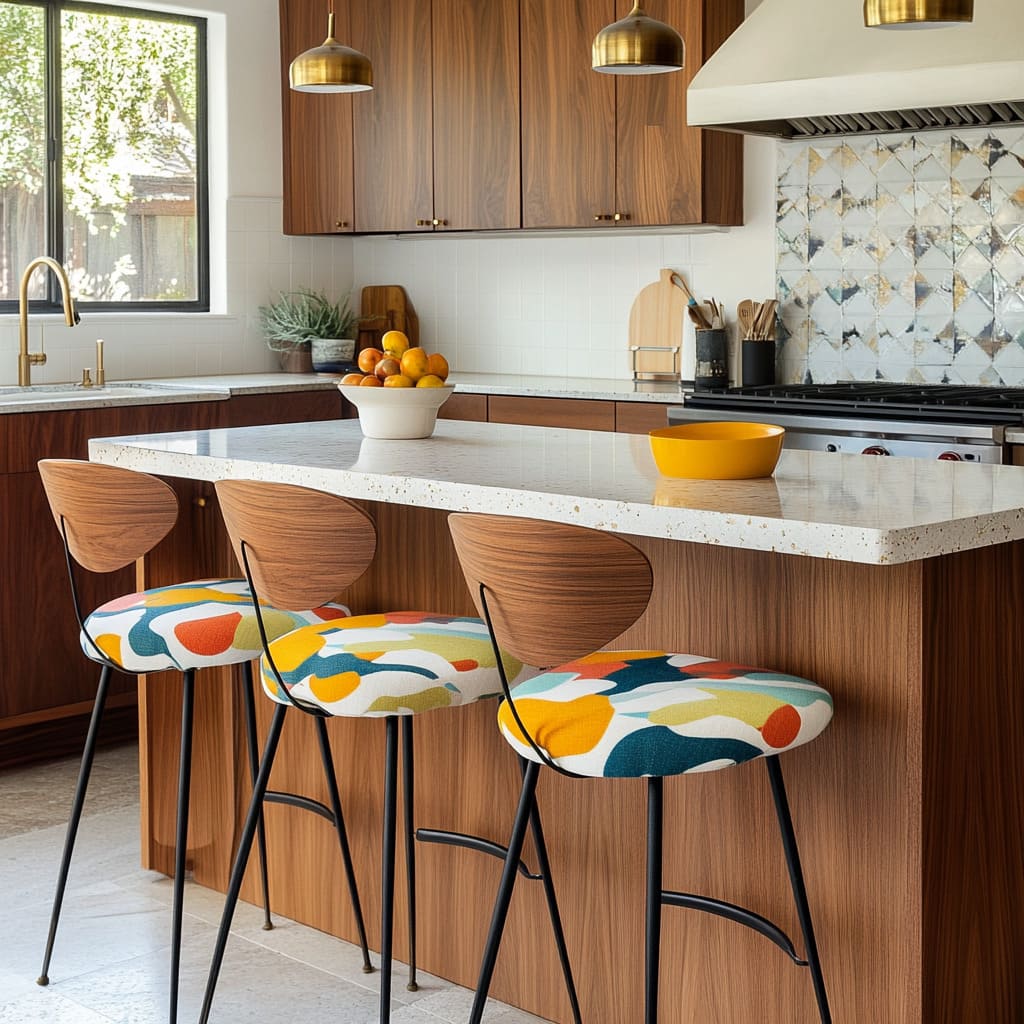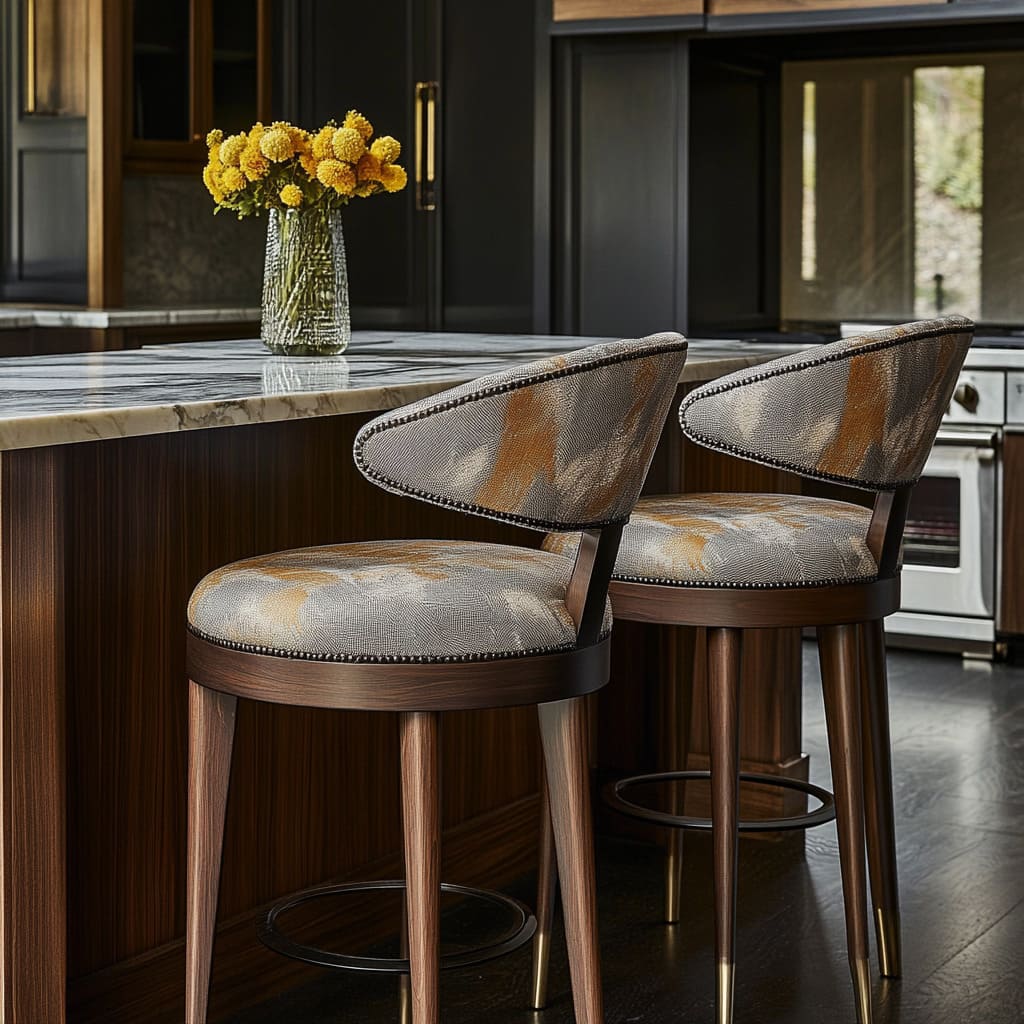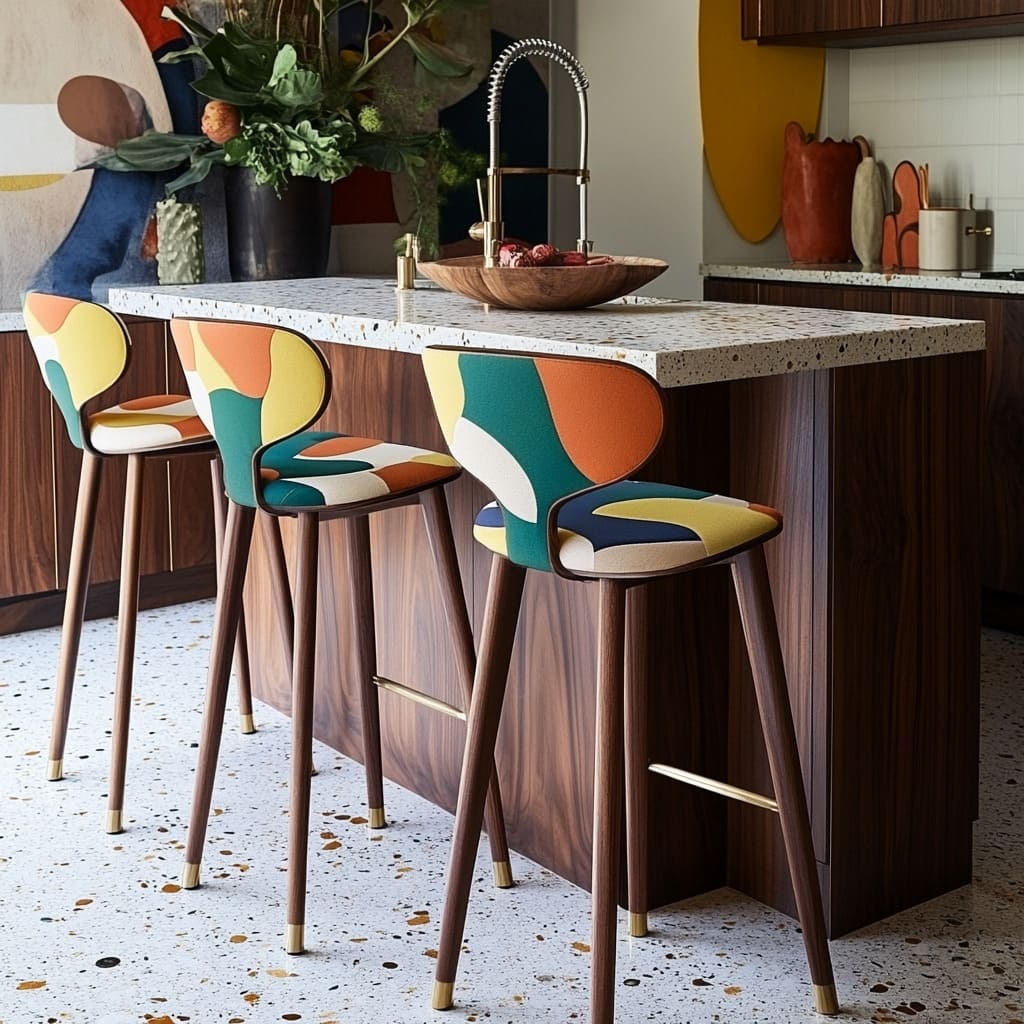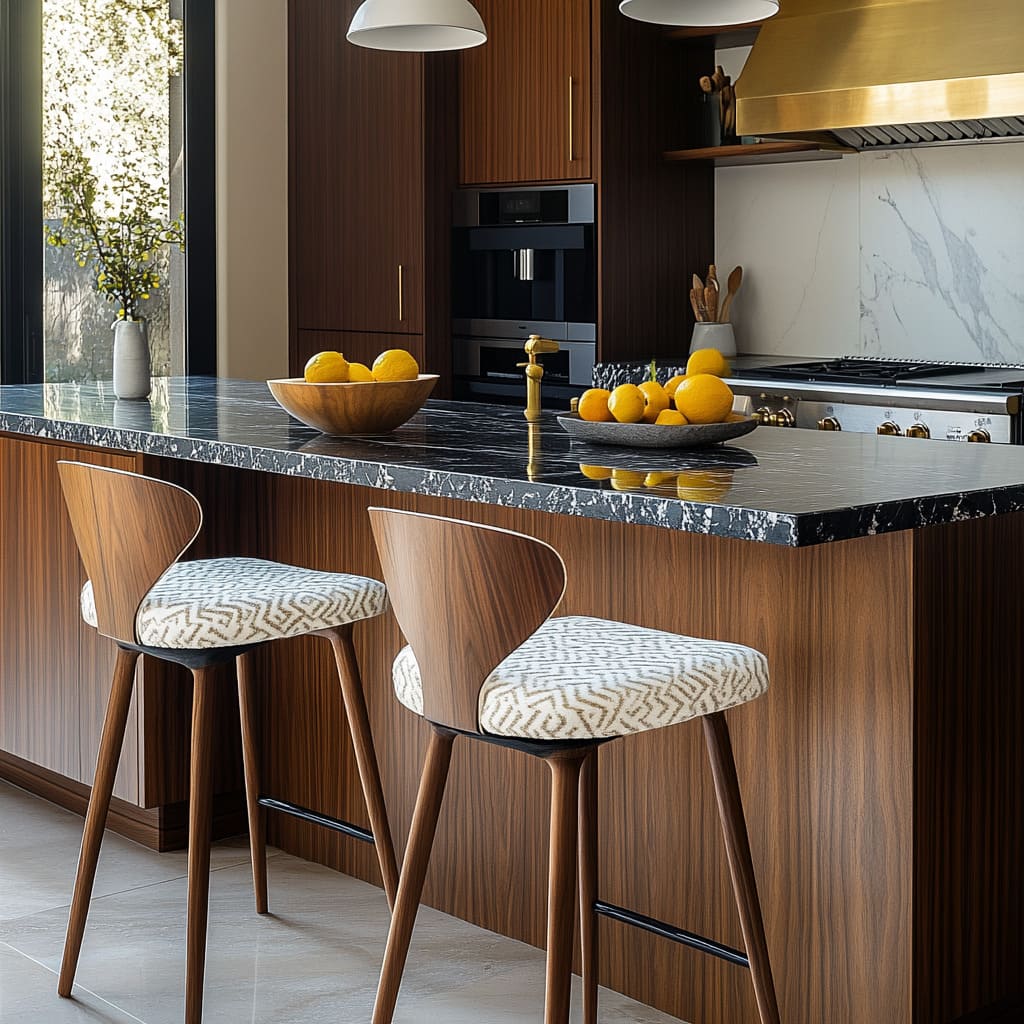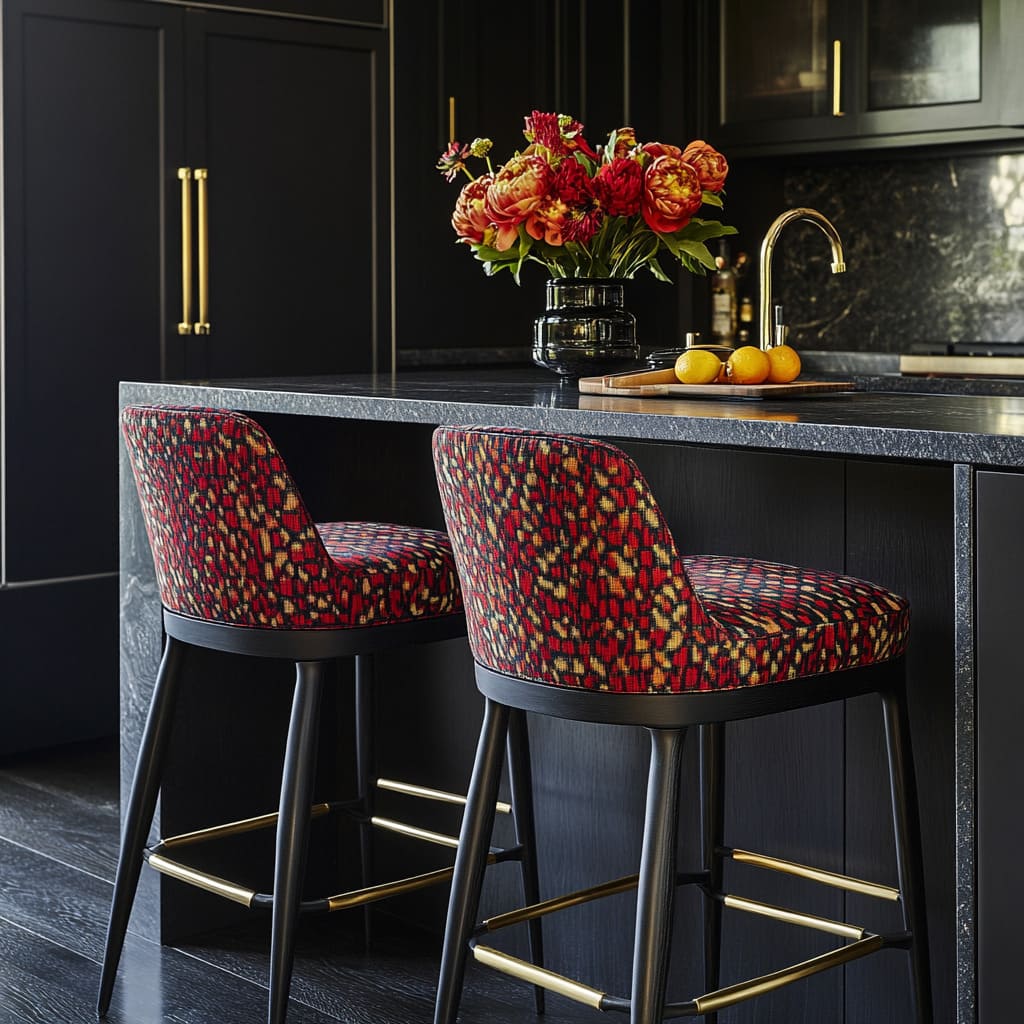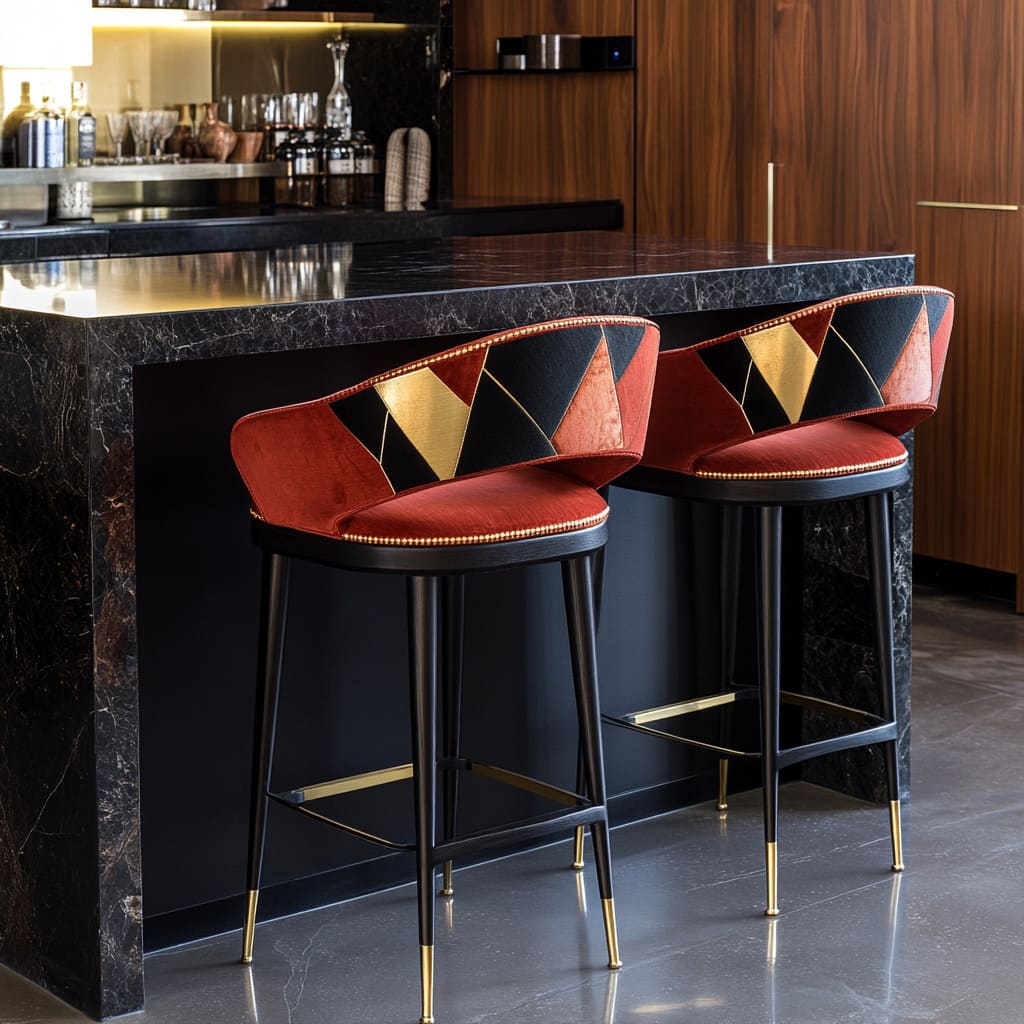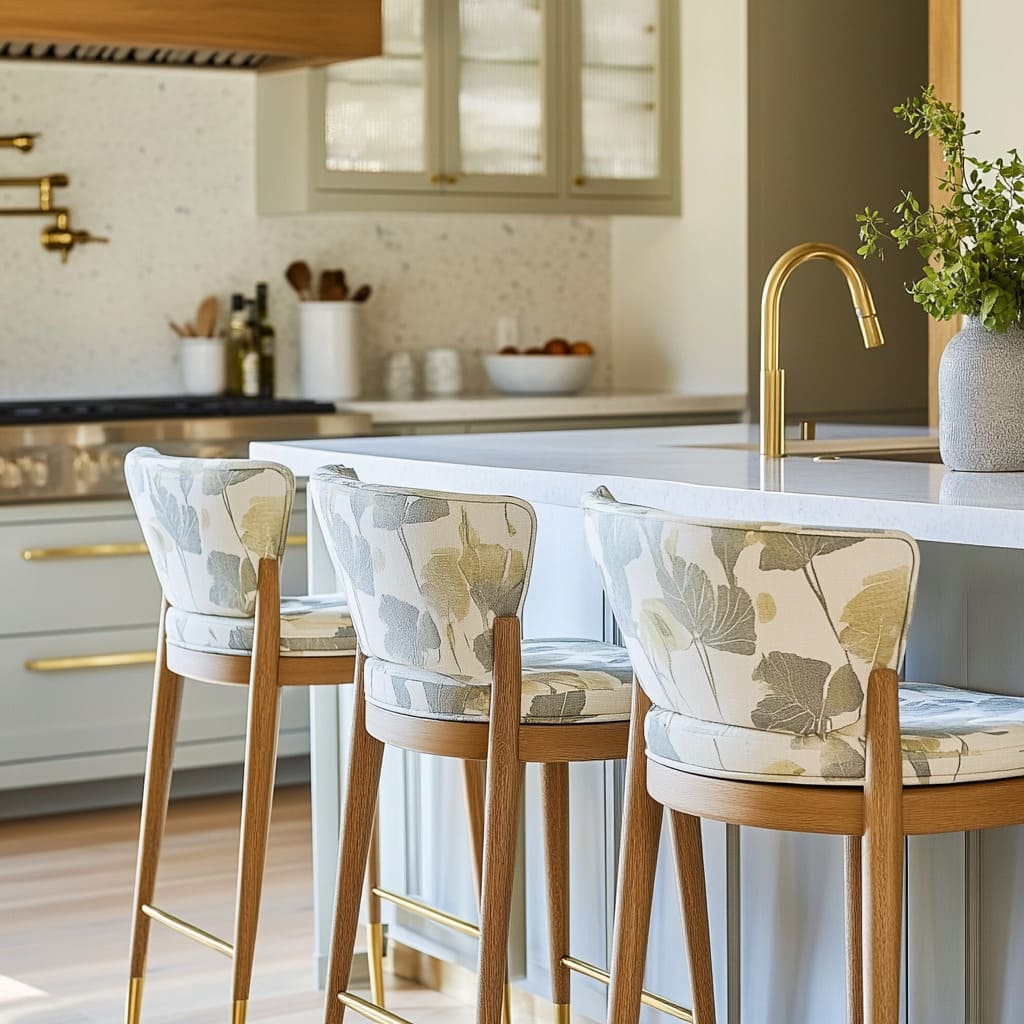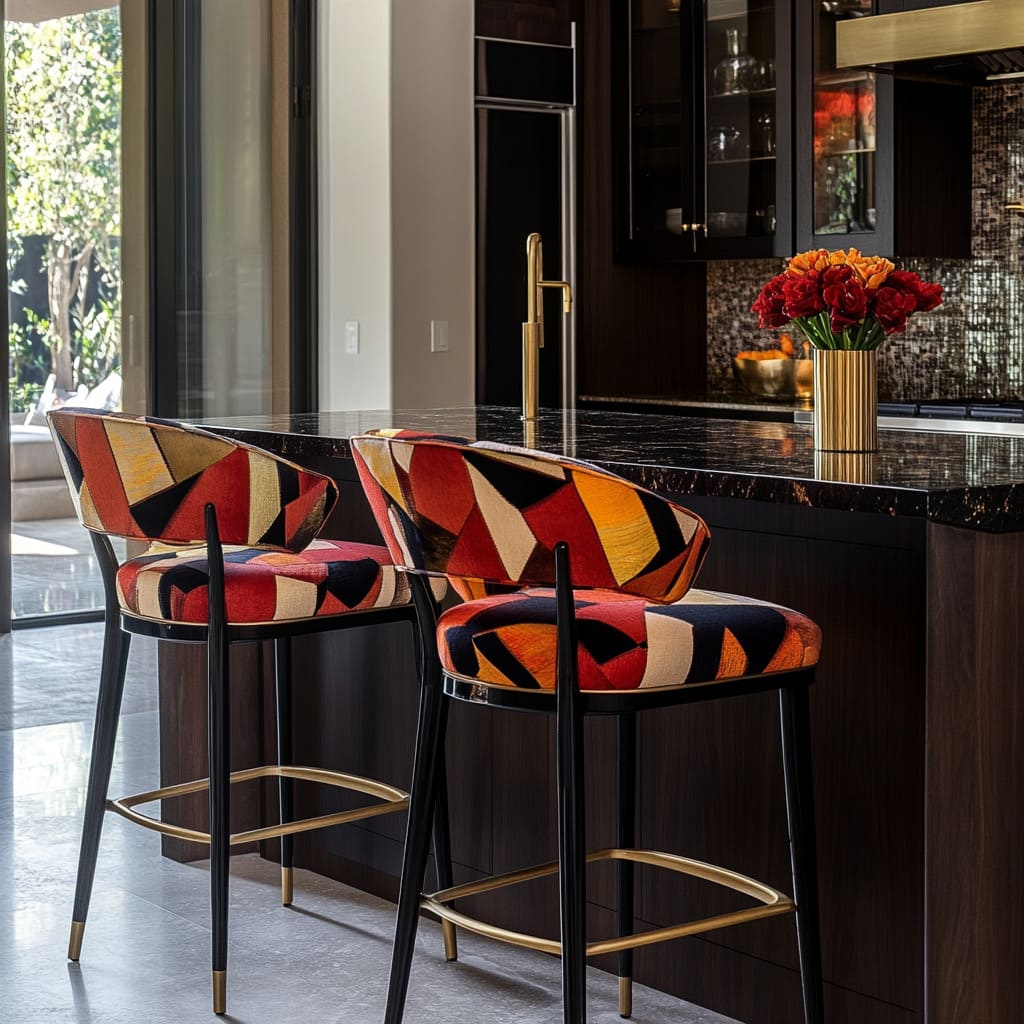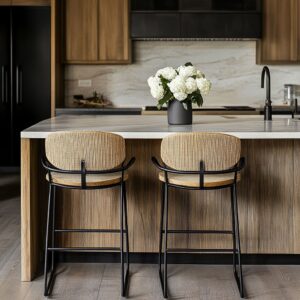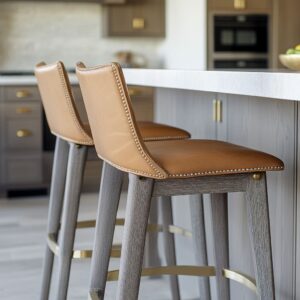When designing a kitchen, seating often gets overlooked in favor of cabinetry, countertops, or appliances. However, the right bar stools can be the unexpected stars of the space, bringing a dynamic mix of color, texture, and design.
Beyond being practical, stools can transform a kitchen’s atmosphere, creating connections between the decor and functional elements.
This article dives into inspiring bar stool design ideas that highlight how upholstery patterns, metal accents, and thoughtful textures can define a kitchen’s aesthetic. Whether you’re looking to make a bold statement or refine an already stylish setup, the right bar stools can tie your kitchen together in ways that feel both intentional and visually striking.
Recurring Themes in Kitchen Bar Stool Styling
Blending Colors with Kitchen Design Elements
Seamless Wood Integration: One noticeable thread in bar stool designs is their harmony with cabinetry wood tones. Whether it’s walnut, oak, or a deep-stained finish, the wooden elements of the stools are often chosen to echo or complement the kitchen’s cabinetry.
This subtle connection establishes visual unity, creating a feeling of completeness.
Echoing Metallic Accents: Metallic details, such as gold or brass footrests, are skillfully aligned with other fixtures like faucets, drawer handles, and lighting. This coordination adds a sense of flow, tying the kitchen together without overwhelming the eye.
These small touches of metal on the stools reinforce the space’s overall design direction.
Color Repetition in Upholstery: Upholstery fabrics often reflect colors found in other kitchen elements. For instance, the hues in bold geometric or abstract patterns are frequently mirrored in marble veining, backsplashes, or wall art.
This thoughtful repetition ensures the stools feel intentionally chosen, contributing to a cohesive color palette.
Balancing Pattern Complexity with Kitchen Minimalism
Focal Point Patterns, Simple Surroundings: Kitchens with stools featuring striking patterns—like vibrant abstract florals or high-contrast geometrics—often balance these bold choices with clean-lined cabinetry and understated countertops. This deliberate pairing allows the stool upholstery to act as a focal point, bringing personality to the space without overwhelming it.
Keeping Energy Balanced: In designs where the kitchen already features dynamic elements, such as heavily veined marble countertops or terrazzo backsplashes, stools often showcase simpler upholstery patterns. This balance ensures that no single element feels out of place, while still allowing the stools to enhance the overall aesthetic.
Textures that Add Depth
Layered Details in Fabric: The textures of the stool fabrics often go beyond simple prints. Features like velvet piping, nailhead trim, or patterns that mimic brushstrokes give the stools a tactile quality.
These details lend an additional layer of sophistication, making the furniture more than just functional—it becomes an integral part of the room’s visual storytelling.
Subtle Shine and Reflection: Some designs incorporate metallic threads or shimmering accents in the upholstery. These elements interact beautifully with light, particularly in kitchens featuring glossy surfaces like polished marble or reflective backsplashes.
This interaction enhances the visual depth of the stools and highlights their presence without overwhelming the room.
Form and Function in Design
Curved vs. Straight Backs: The choice between curved and straight-backed stools reflects both style and usability.
Curved backs provide a sculptural, inviting look that leans into comfort, while straight backs suit kitchens with a sleeker, more formal vibe. Each design caters to a specific aesthetic and frequency of use, ensuring the stools fit both the room and the homeowner’s needs.
Footrest and Leg Details: Footrests, whether circular, rectangular, or minimalist, offer practical comfort while contributing to the stool’s style. Paired with legs that are tapered, angled, or straight, these details reinforce the kitchen’s overall design.
Brass and black metal finishes on footrests tie back into broader kitchen accents, like faucets and lighting, making the space feel cohesive.
By focusing on how these elements come together—color, pattern, texture, and structure—kitchen bar stools become more than seating. They serve as thoughtful, curated pieces that bring depth and character to any space.
Whether drawing inspiration from classic designs or bold, contemporary bar stool designs, these choices showcase how every detail plays a part in a kitchen’s aesthetic success.
Unique Design Elements That Define Bar Stool Styling
Patterns Drawn from Nature’s Beauty
Floral and Botanical Inspirations
Bar stools with muted floral prints or leaf-like patterns bring an organic touch to kitchen spaces. These designs subtly complement greenery or potted plants, creating a natural flow between the furniture and its surroundings.
The soft tones in these patterns evoke a sense of calm while maintaining visual interest.
Marble-Inspired Swirls
Upholstery featuring swirling designs that mimic marble veining seamlessly bridges the gap between the bar stool and stone countertops. This intentional harmony enhances the overall look and connects individual kitchen elements into a cohesive design.
Earthy Camouflage and Abstract Leaves
Blends of rust, olive, beige, and cream create stools that exude a grounded, earthy vibe. These tones and patterns pair effortlessly with wood cabinetry and stone countertops, highlighting the organic textures of the materials.
This approach ensures that stools feel like an extension of the kitchen’s natural elements, rather than stand-alone pieces.
Bold Geometric Statements
Angular and Color-Blocked Designs
Modern bar stool ideas for kitchen islands often feature angular motifs like triangles, diamonds, chevrons, and herringbone patterns. These designs reinforce a contemporary aesthetic and work well with other angular features in the kitchen, such as fluted cabinet fronts or geometric backsplash tiles.
Art Deco Influence
Bold patterns with triangles, repeated lines, and metallic gold details bring a sense of vintage sophistication. These stools shine in kitchens with black cabinetry and marble countertops, introducing a touch of classic glamour without overpowering the space.
Their strong visual presence enhances the richness of other high-contrast elements in the room.
Vibrant and Eye-Catching Color Palettes
Abstract Expressionist Energy
Bar stools with vibrant, painterly prints—featuring oranges, teals, reds, and yellows—become instant focal points in kitchens. These lively designs add energy to neutral-toned spaces, transforming them from understated to expressive.
The playful yet artistic patterns ensure that the stools double as functional furniture and decorative art.
Monochromatic Graphics
For a modern edge, black-and-white prints with geometric or zigzag designs provide a crisp contrast. These stools pair beautifully with dark wood cabinetry, such as walnut, offering a perfect balance between boldness and sophistication.
Dramatic Jewel Tones
Deep colors like navy and gold, paired with accents of red, black, or teal, make a striking statement. These hues work exceptionally well with metallic hardware or marble finishes, ensuring the stools remain cohesive with the overall kitchen palette while standing out as centerpiece elements.
By focusing on the intricate details of patterns, colors, and textures, these bar stool designs redefine how seating integrates into kitchen aesthetics. Whether inspired by nature or bold geometric forms, the options available for bar stools at a kitchen island go beyond mere practicality, offering style and personality that elevate the space.
Emerging Trends in Kitchen Bar Stool Design
Subtle Metallic Integration
One of the more intriguing trends is the addition of metallic accents woven directly into fabric patterns. Subtle gold or silver threads are skillfully incorporated into geometric or abstract designs, offering a slight shimmer that reflects light without overwhelming the space.
These understated metallic details create a natural connection with the growing preference for gold or brass hardware in modern kitchens, such as faucets, cabinet handles, or light fixtures. This blending of soft textiles and metallic elements adds a touch of refinement while maintaining a functional and approachable vibe.
Merging Classic Prints with Modern Spaces
The pairing of traditional patterns like houndstooth or toile with sleek, contemporary interiors is a refreshing design choice that balances nostalgia and modernity. These timeless prints act as conversation starters, bridging generational aesthetics while bringing depth and character to minimalist spaces.
When placed in kitchens with flat-panel cabinets, monochromatic backsplashes, or open shelving, these stools stand out as both functional and decorative, making the seating feel current while nodding to history.
Textural Layering on Stool Backs
Bar stools are increasingly being designed as works of art, with particular attention paid to the backrest. Textural layering—combining materials like pleated fabrics, leathers, or even embossed textiles—creates a three-dimensional appeal that transforms the stool into a sculptural feature.
This trend emphasizes small, tactile details that can be appreciated up close, enhancing the visual and physical experience of the kitchen. These layered backs add depth, making the stools a dynamic focal point even when not in use.
Coordinating with Bold Countertops
Statement countertops, especially those crafted from boldly veined marble or terrazzo, have become central elements in contemporary kitchen designs. To harmonize with these striking surfaces, bar stools are being tailored to complement their unique textures and colors.
Upholstery that mirrors the tones or patterns of these countertops provides a seamless design connection, ensuring the kitchen feels unified without becoming monotonous. For example, stools featuring upholstery with swirling patterns or muted specks reflect the intricate detailing of the countertop, creating a balanced visual narrative.
By focusing on these forward-thinking kitchen bar stool ideas, homeowners can add layers of sophistication and individuality to their spaces. Whether through the shimmer of metallic threads, the juxtaposition of classic and modern prints, or the artful textural details on backs, these trends showcase how bar stools can elevate a kitchen’s style without sacrificing comfort or utility.
Practical Tips for Achieving a Harmonious Kitchen Design
Balance Boldness
When choosing a dramatic print for your bar stools, ensure the surrounding elements create a harmonious backdrop. Bold geometric or vibrant patterns can shine when paired with neutral or minimalist surfaces like a polished countertop or understated backsplash.
This deliberate contrast allows the stools to take center stage without creating a visually overwhelming space. Conversely, a striking marble or terrazzo countertop may call for simpler stool upholstery to achieve a balanced kitchen counter bar design.
Repeat a Core Color
A cohesive kitchen aesthetic often hinges on the repetition of key colors. Identify a dominant shade in your bar stool upholstery—perhaps a warm terracotta, deep blue, or rich gold—and subtly integrate it into other elements of the kitchen.
Think cabinet handles, decorative vases, or even a framed piece of art. These repeating accents build continuity throughout the space, ensuring that the bar stools feel intentionally tied to the overall decor.
Think About Texture
Texture adds depth to your kitchen design and often goes unnoticed in initial planning. Opt for stool upholstery with a subtle sheen, velvet piping, or intricate weaves to enhance tactile sophistication.
These textures complement reflective surfaces, such as polished marble countertops, while also introducing a layer of warmth. Thoughtful textural choices can elevate a kitchen’s ambiance without relying solely on bold colors or patterns.
Match the Metals
Consistency in metal finishes is an easy way to create a polished and cohesive kitchen. For example, align the metal accents on your bar stools—such as footrests—with the tones of your faucets, pendant lights, or cabinet hardware.
Gold or brass details can add warmth, while black or chrome elements provide a sleek edge. If you choose mixed metals, carefully distribute them in a balanced way to avoid clashes, ensuring the room maintains a well-structured appearance.
Consider Ergonomics
Bar stool design isn’t just about looks; comfort plays a critical role, especially if your kitchen island doubles as a social or dining hub. High backs, plush cushioning, and supportive curves not only enhance the aesthetic but also make the space inviting for longer use.
Choosing functional stools doesn’t mean compromising on style; instead, it allows the perfect blend of comfort and design to suit any modern home.
When planning your kitchen, these bar stool decor ideas can guide you toward a space that feels both stylish and cohesive. Whether you’re focusing on statement pieces or subtle details, keeping the room balanced ensures your stools become a standout feature without overwhelming the overall design.
Remember, thoughtful choices around color, texture, and ergonomics can tie together your kitchen and make it a reflection of your personal style.
Final Thoughts on Creating Impactful Kitchens
The right stool bar design can transform the overall character of a kitchen, turning functional seating into a defining decor element. These patterned stools show how upholstery isn’t just a practical choice but also a design statement that adds depth and personality.
Whether introducing vibrant colors, subtle botanical patterns, or bold geometric shapes, bar stools can set the tone for the room and tie together various design elements.
By thoughtfully considering the scale of patterns, the finishes of metals, and the interplay of textures, homeowners can ensure their stools seamlessly integrate with the space. This attention to detail prevents the seating from feeling out of place, instead making it an intentional focal point.
Customizing upholstery to echo the kitchen’s key materials—like stone countertops or wooden cabinetry—can further enhance this cohesive look.
